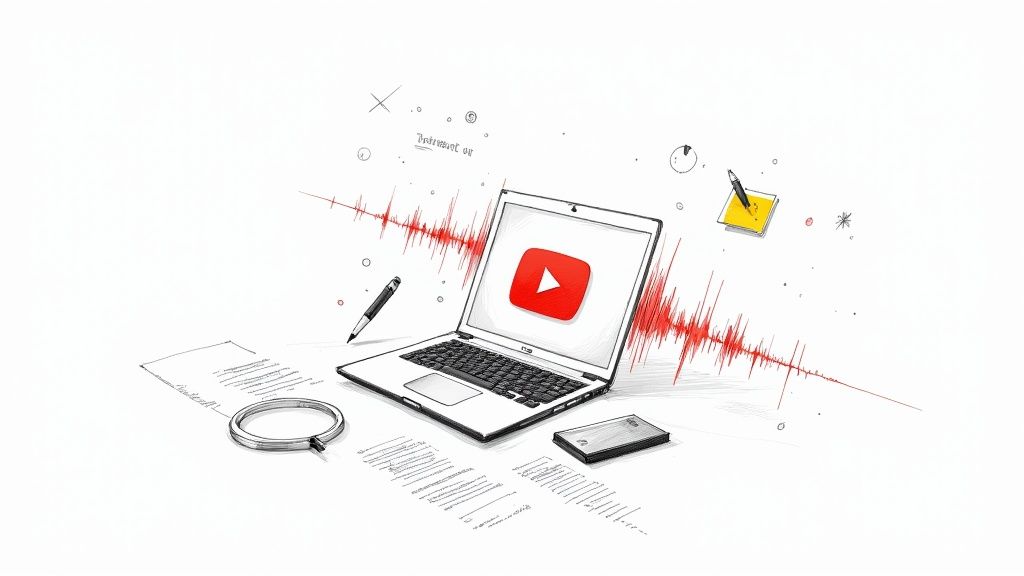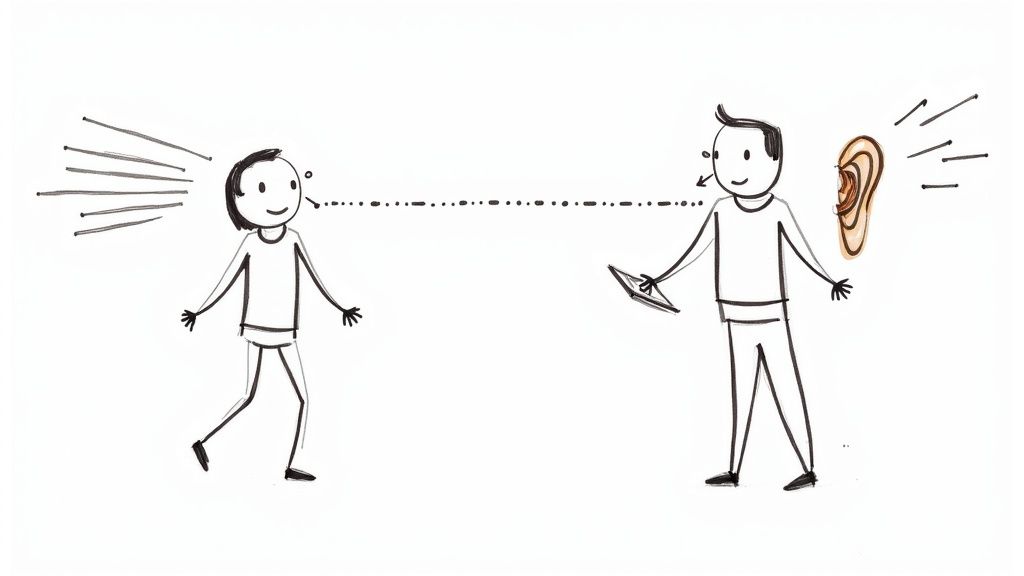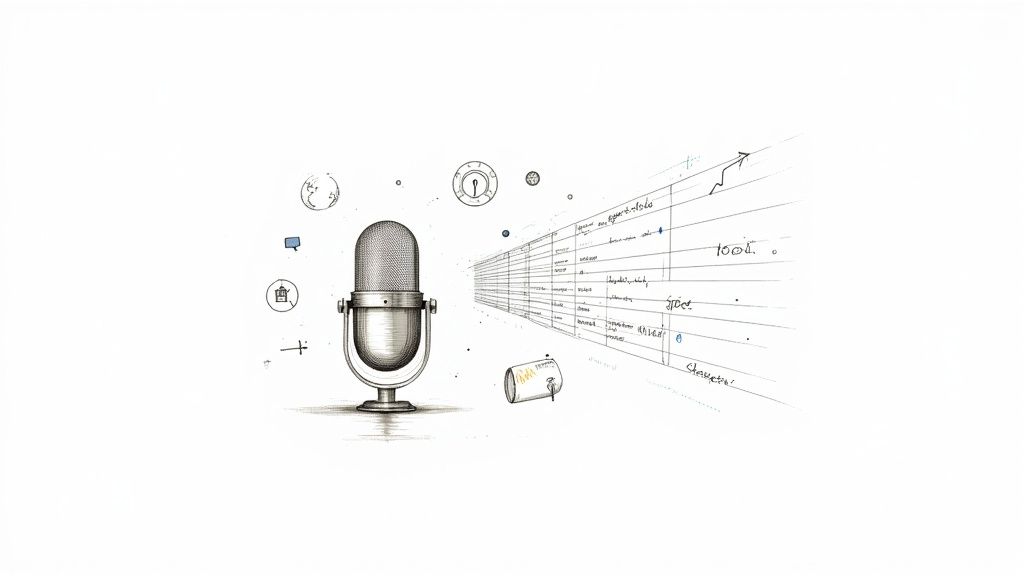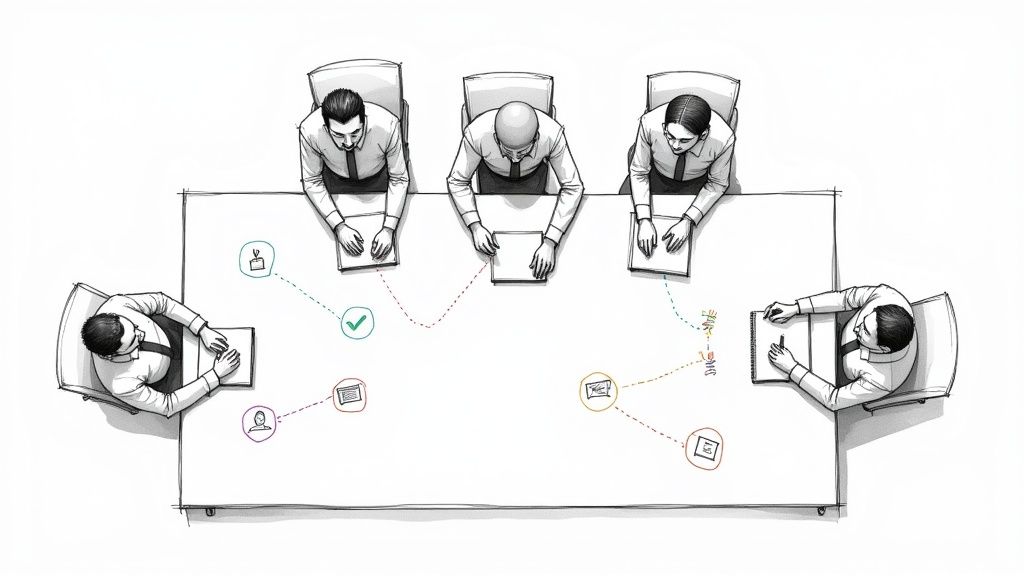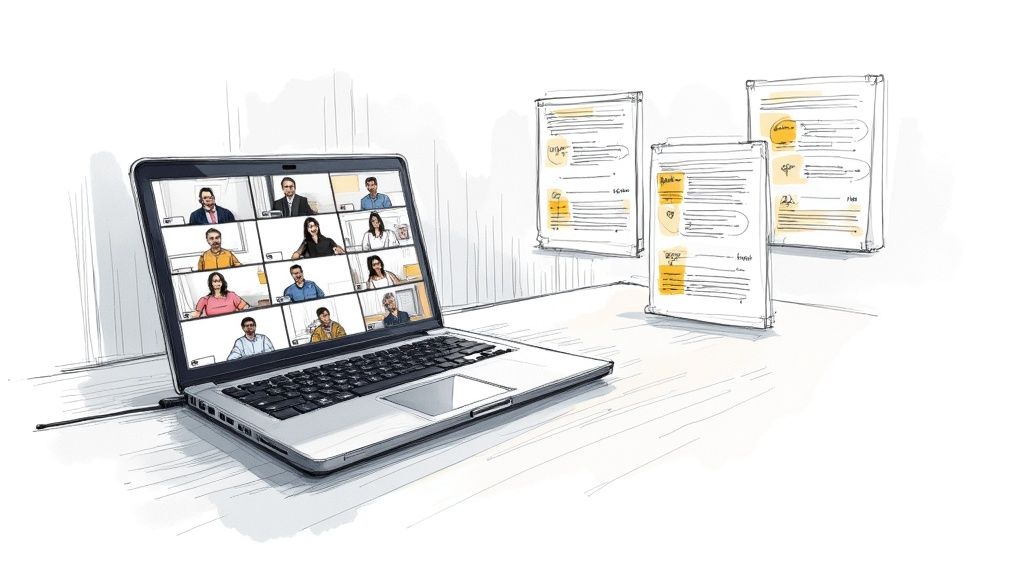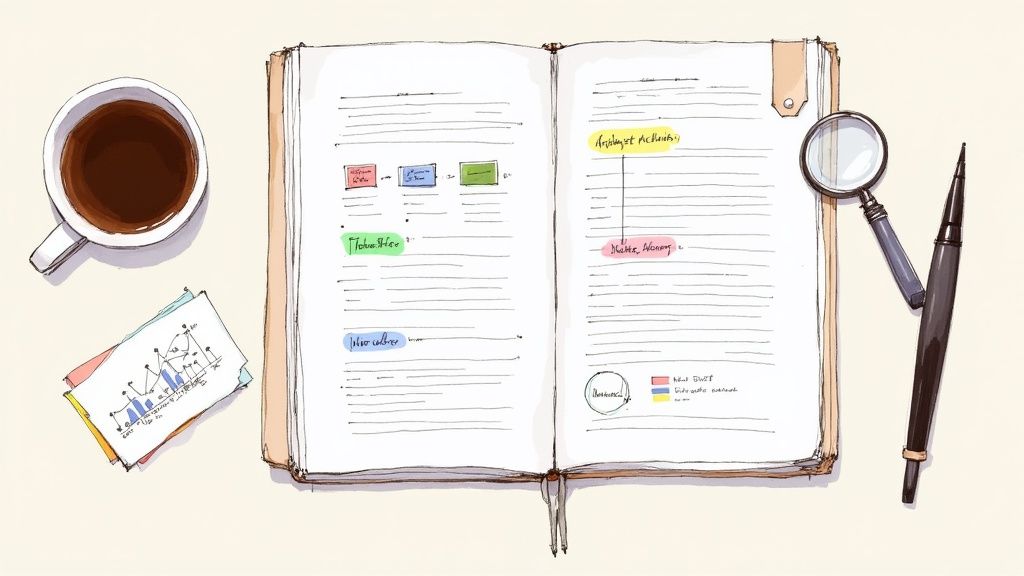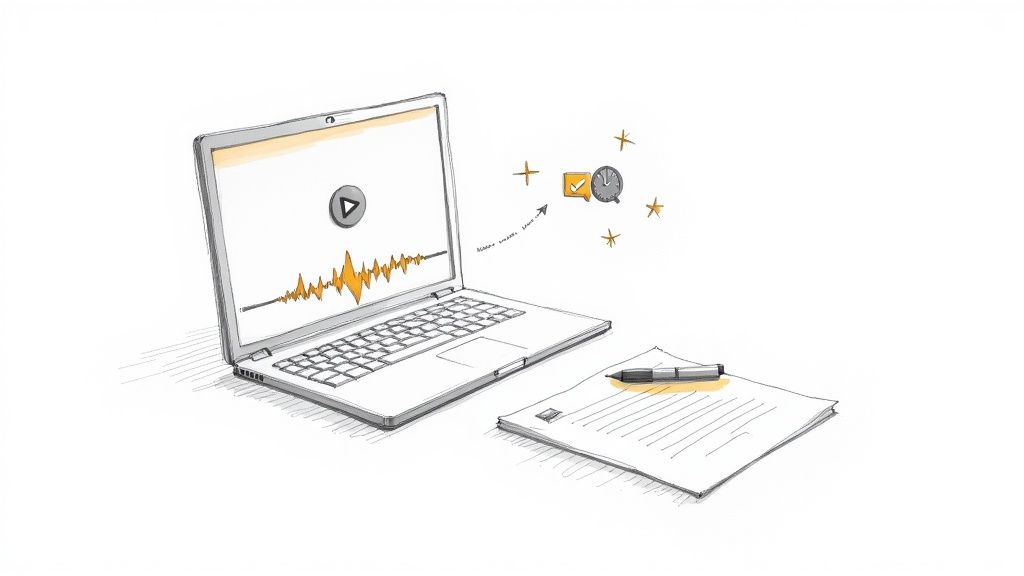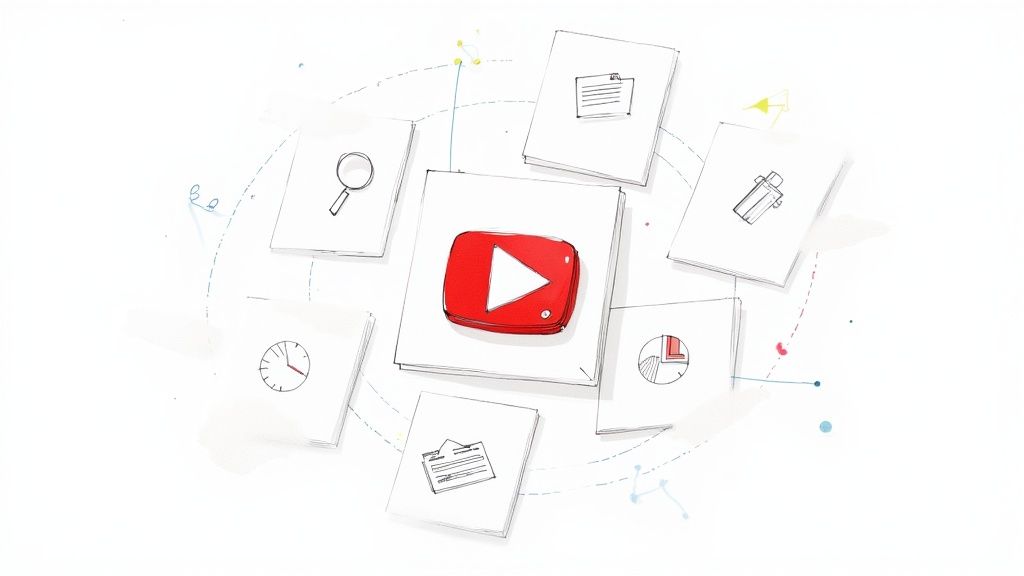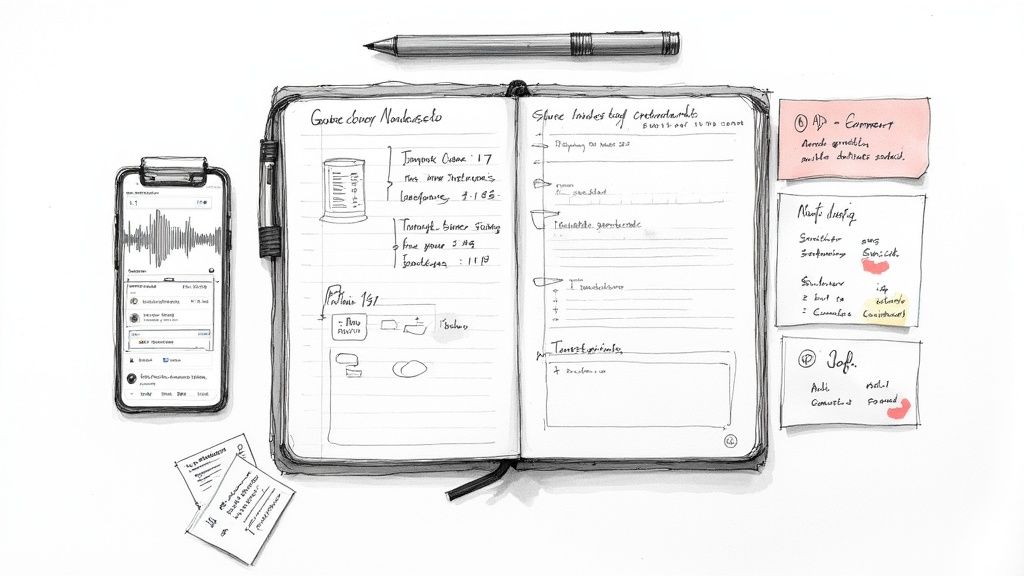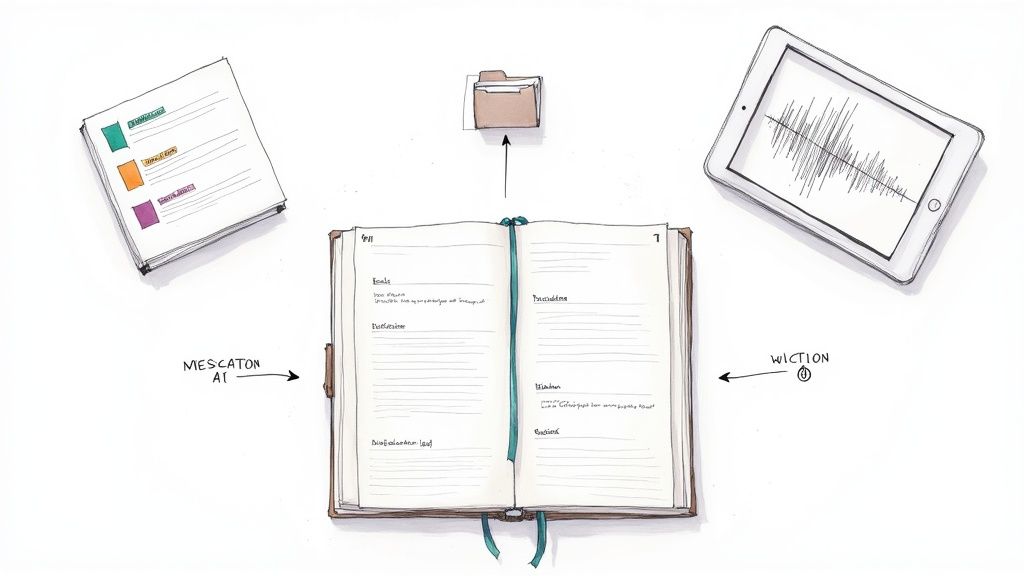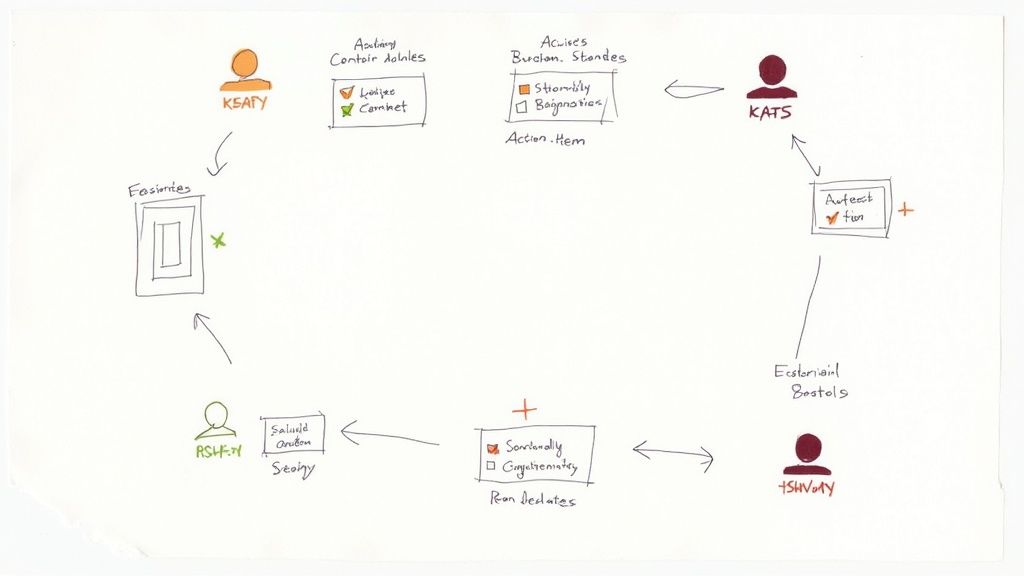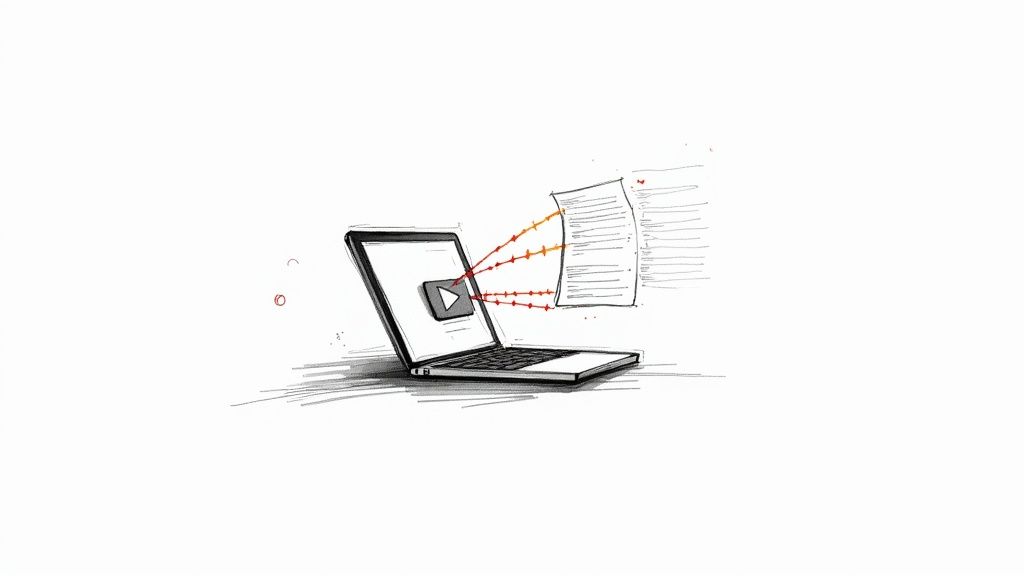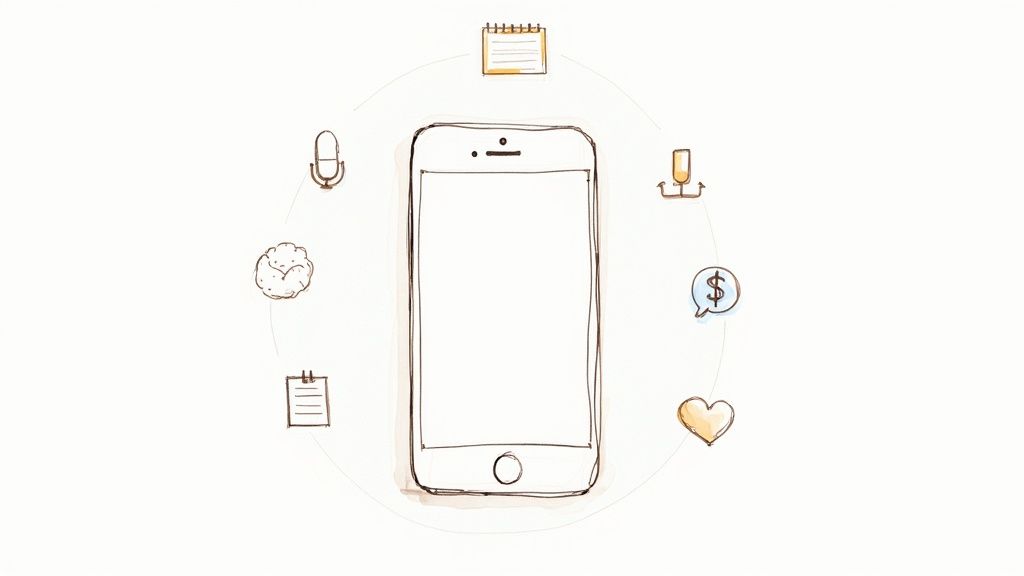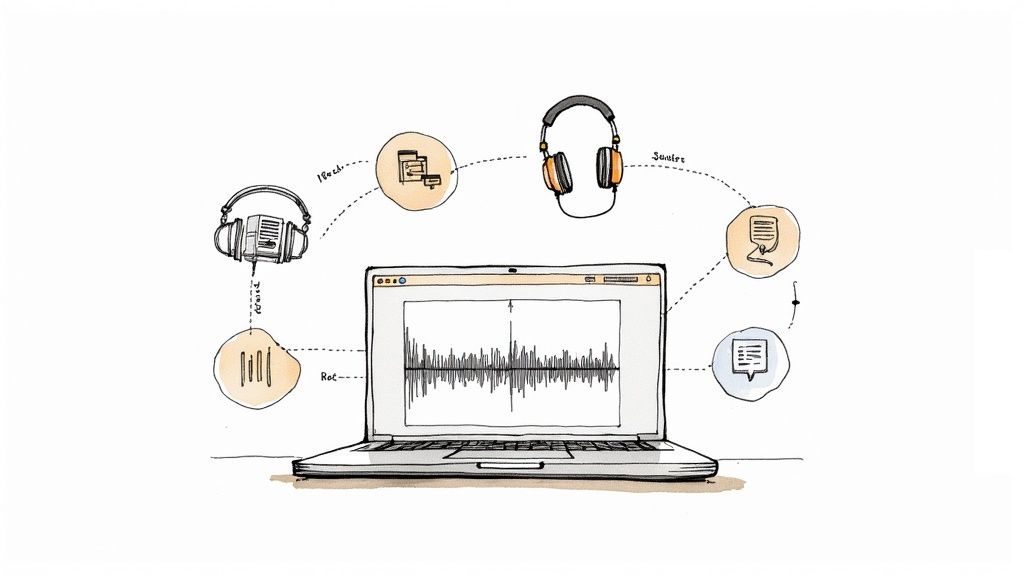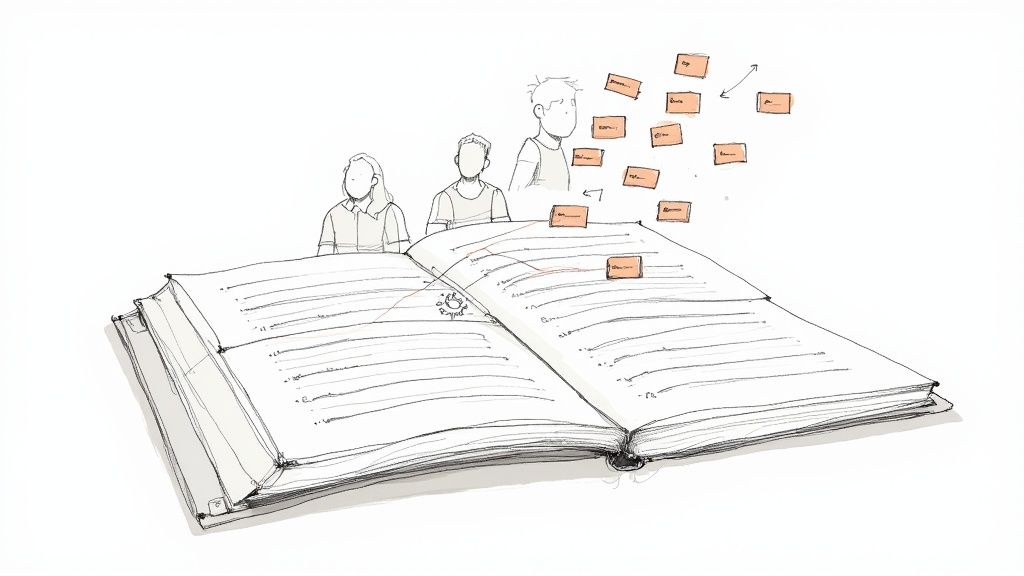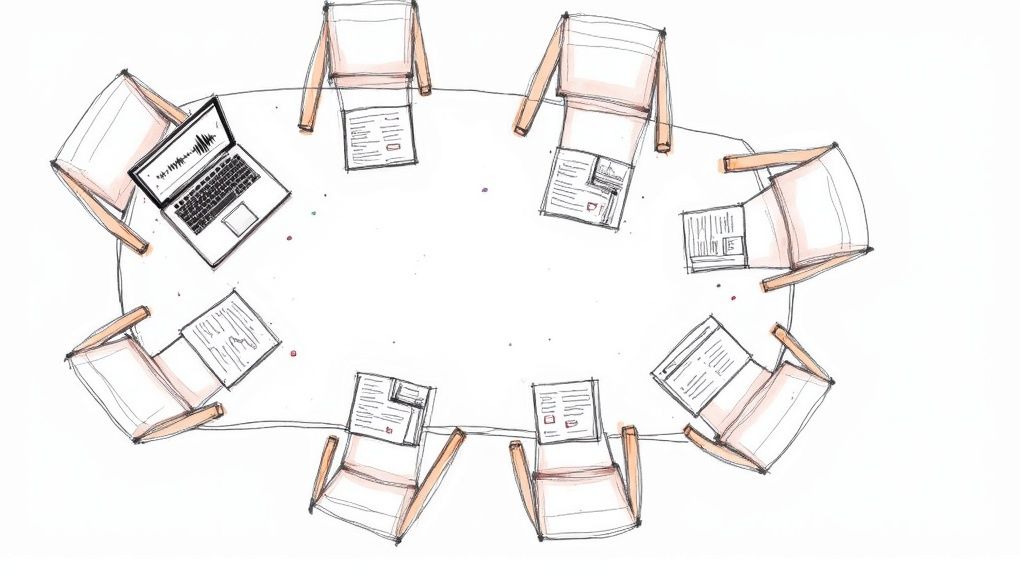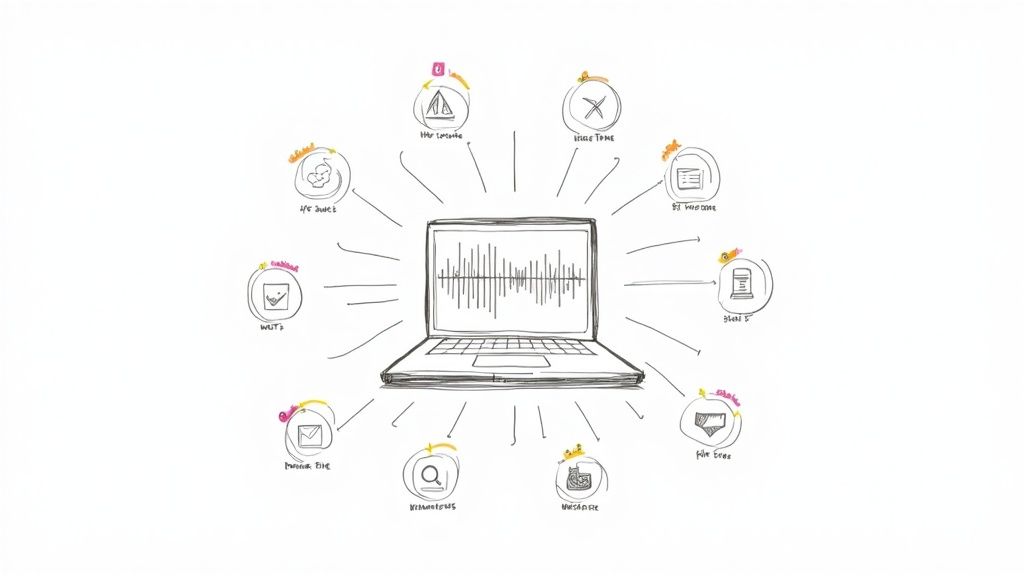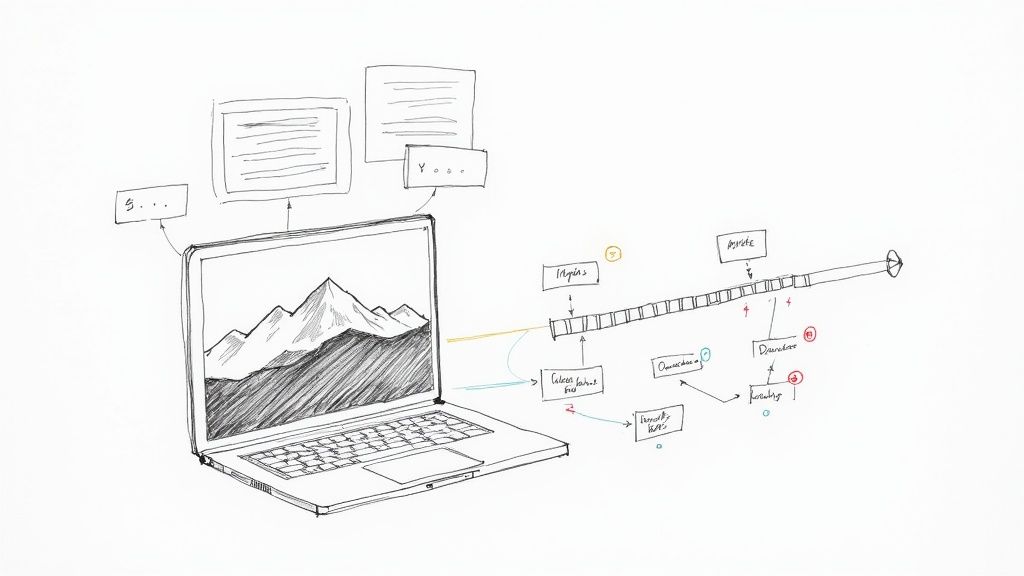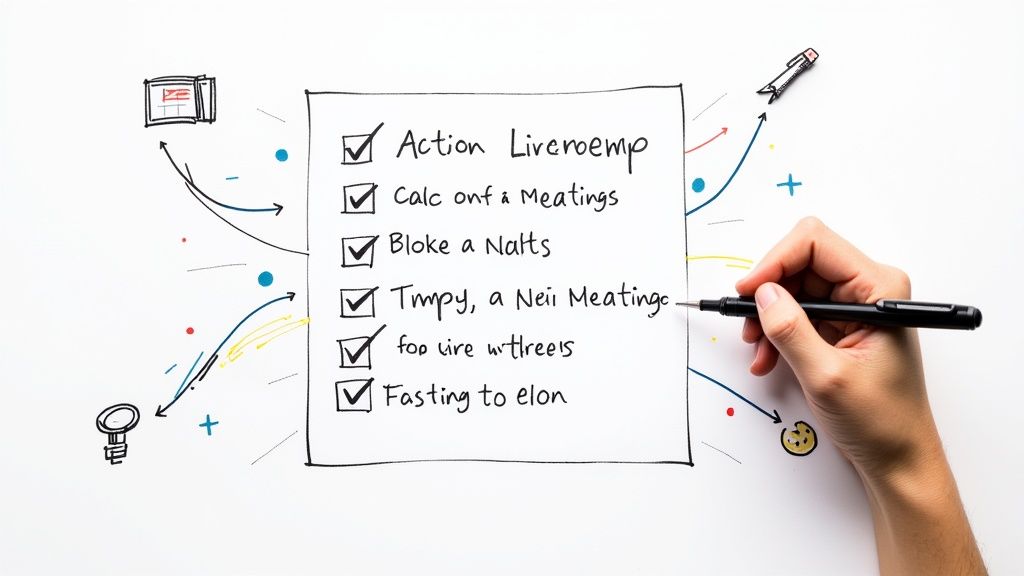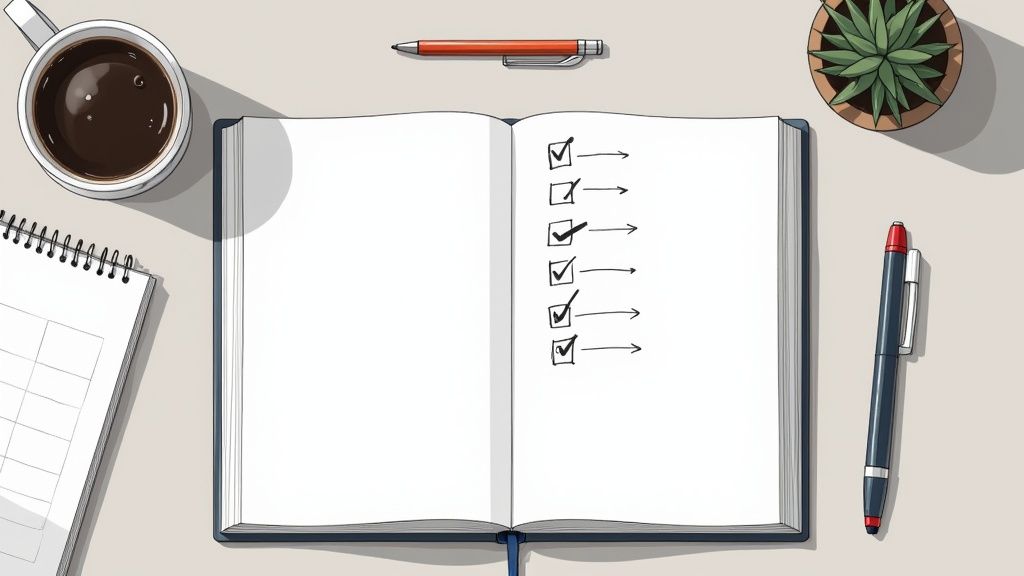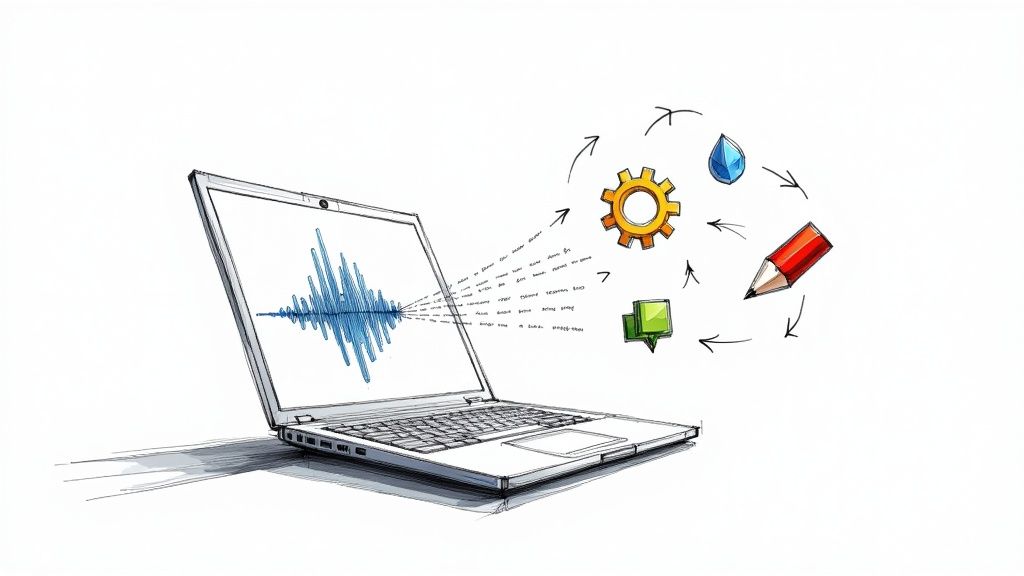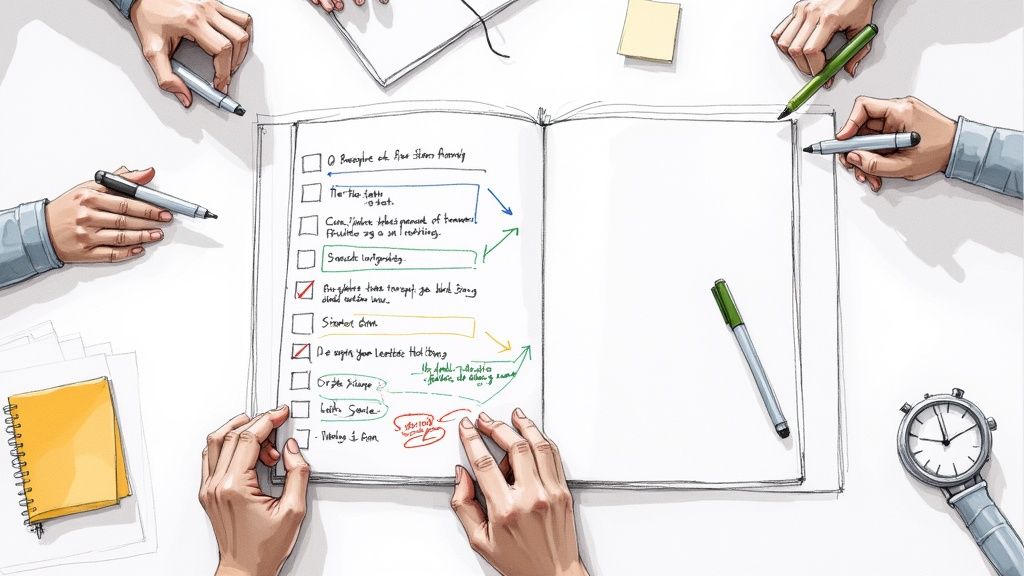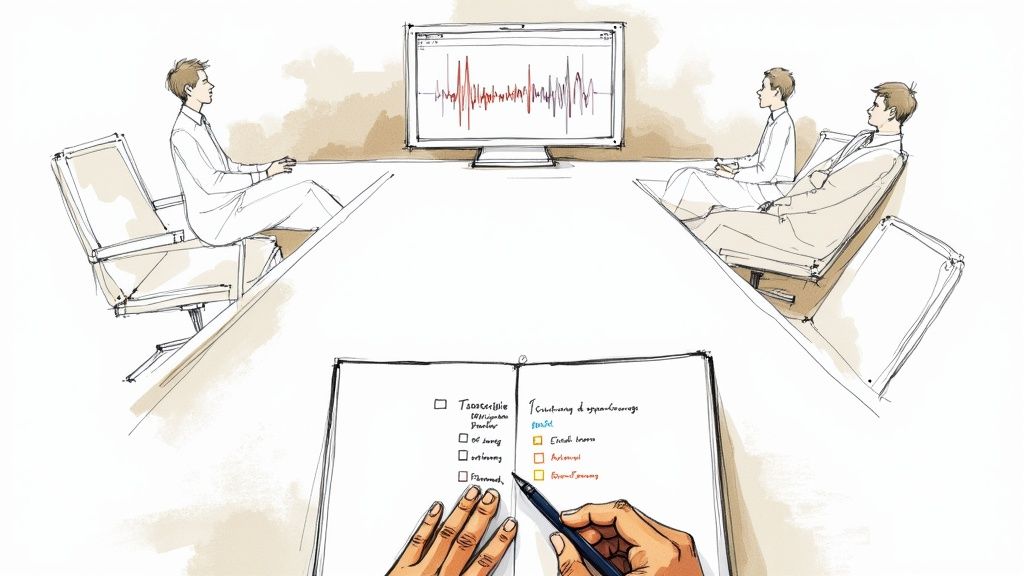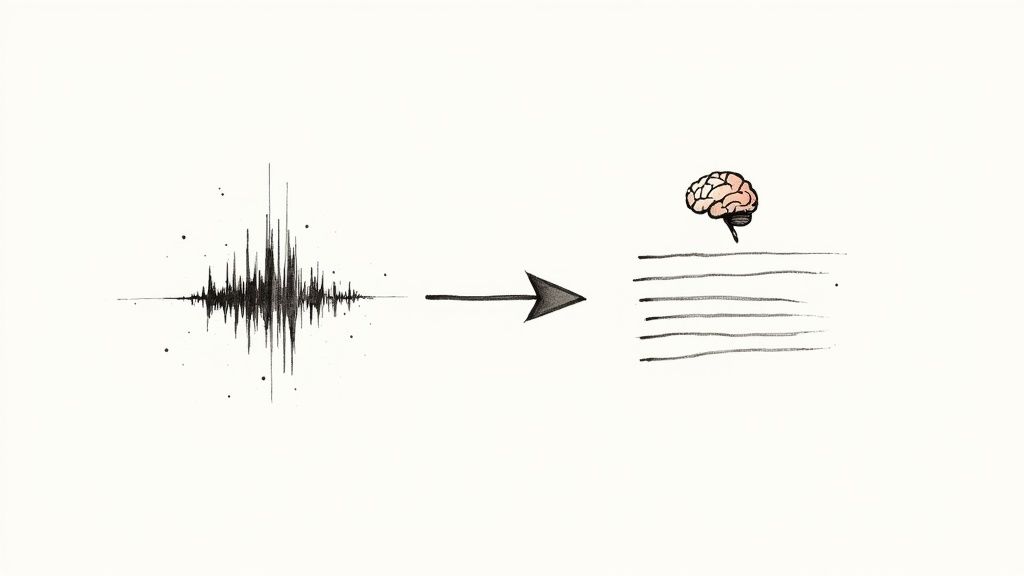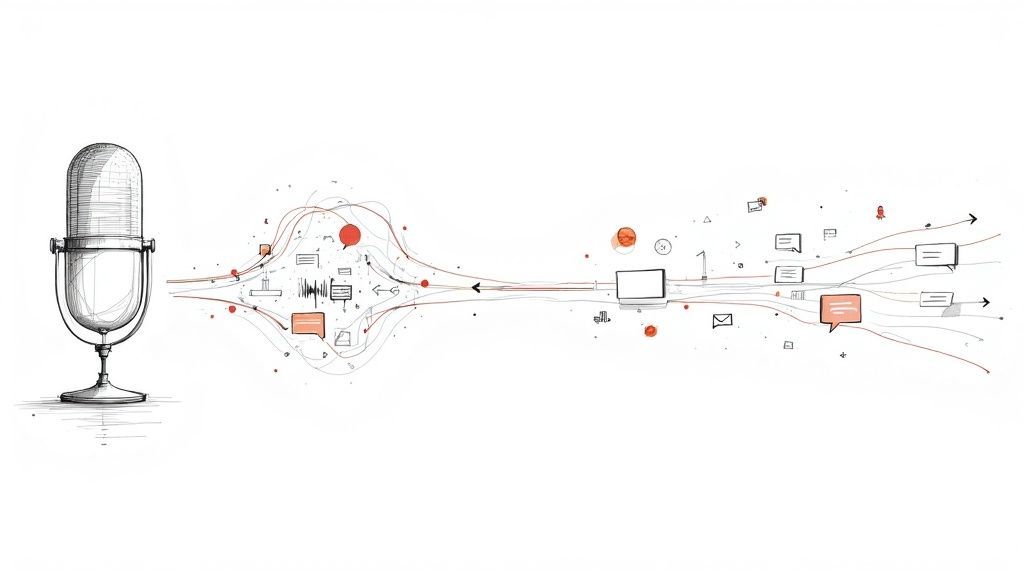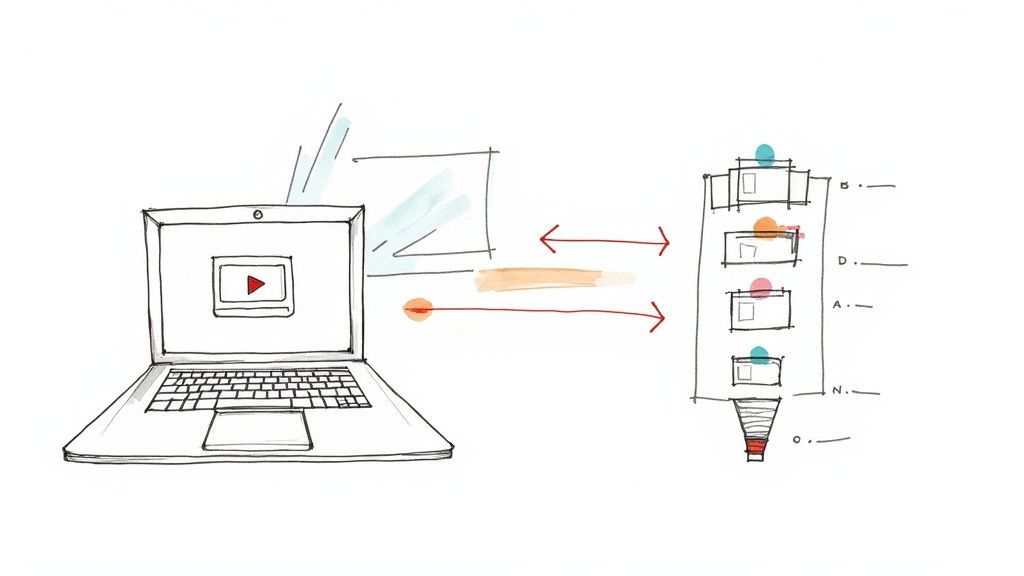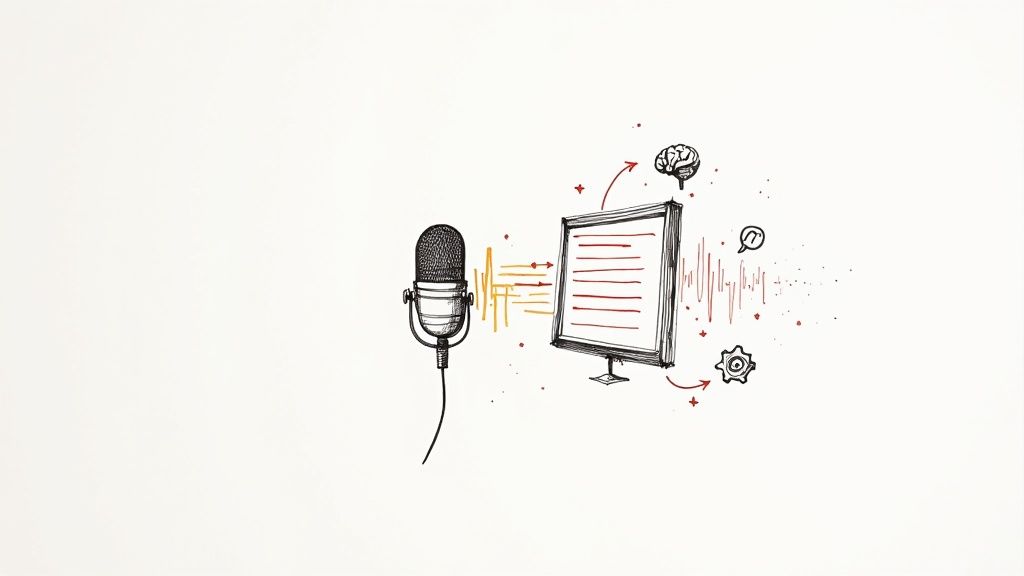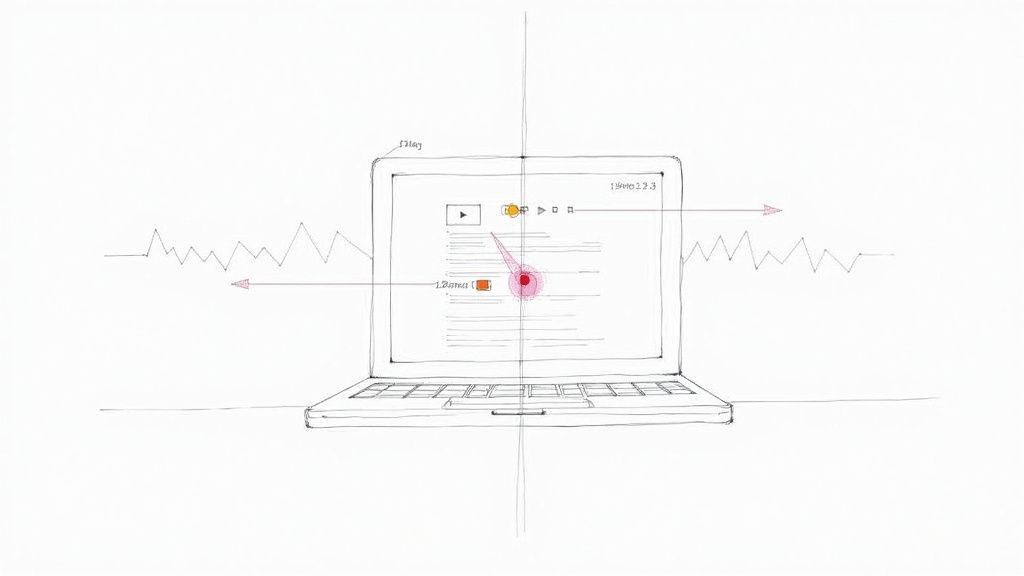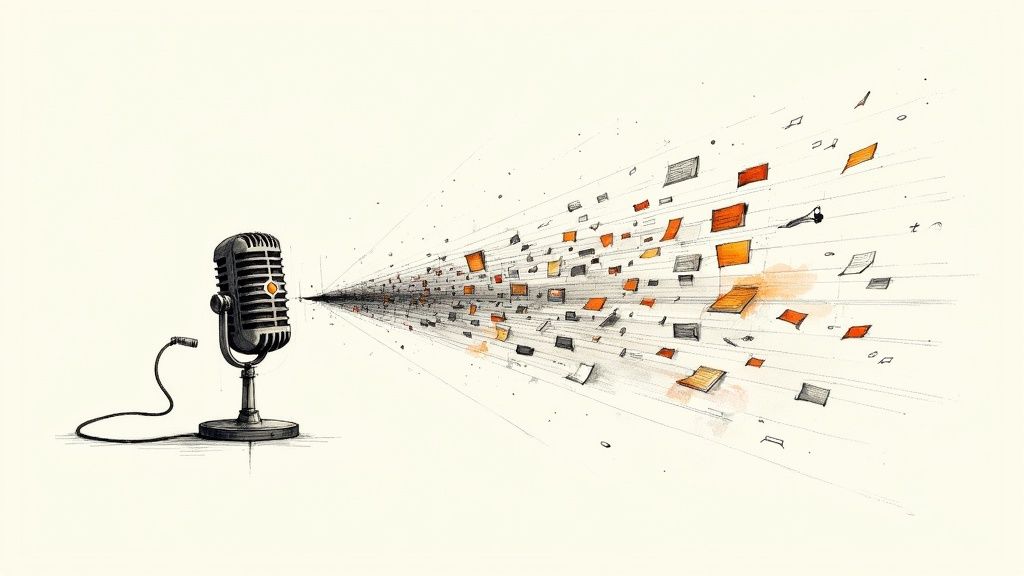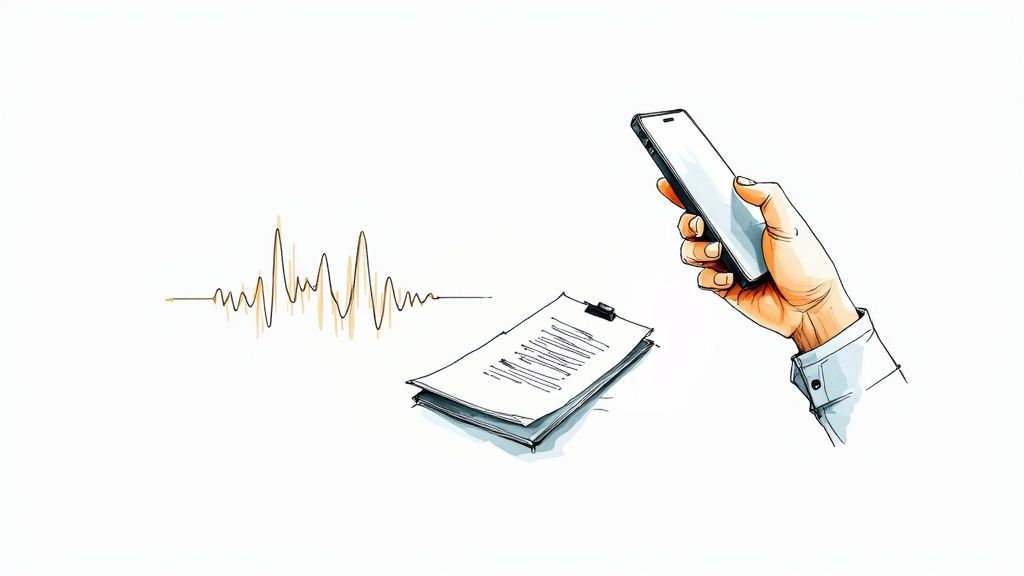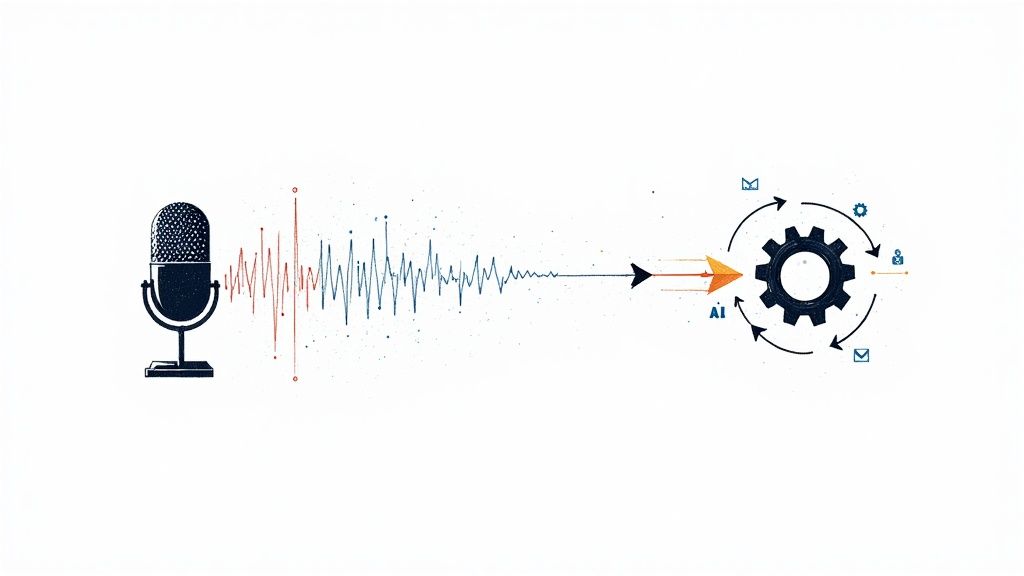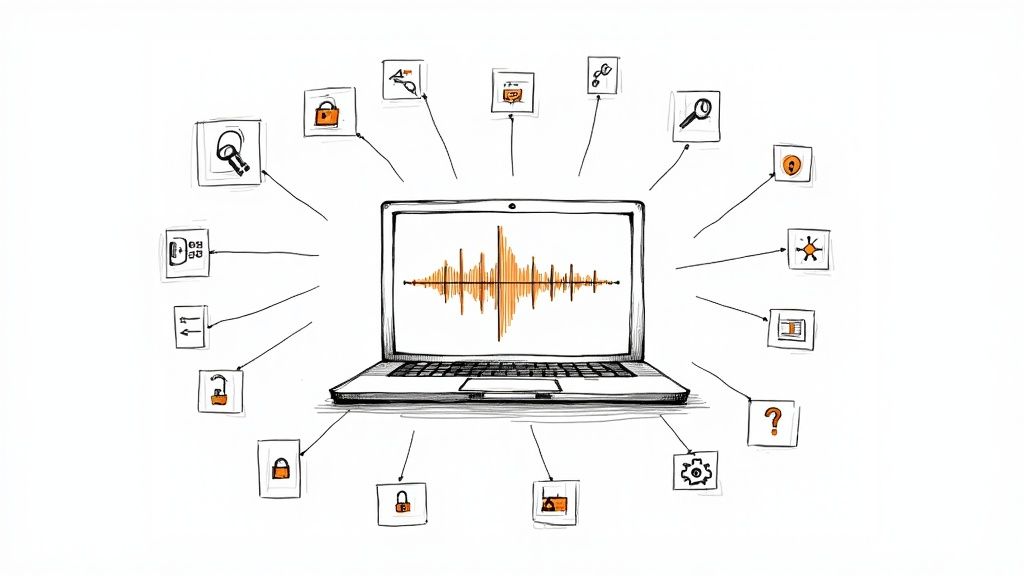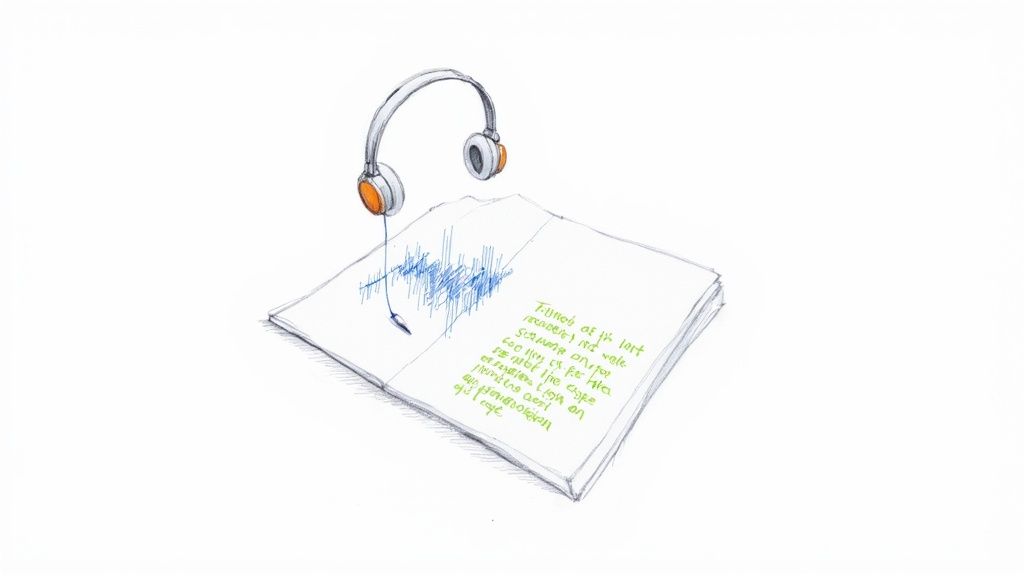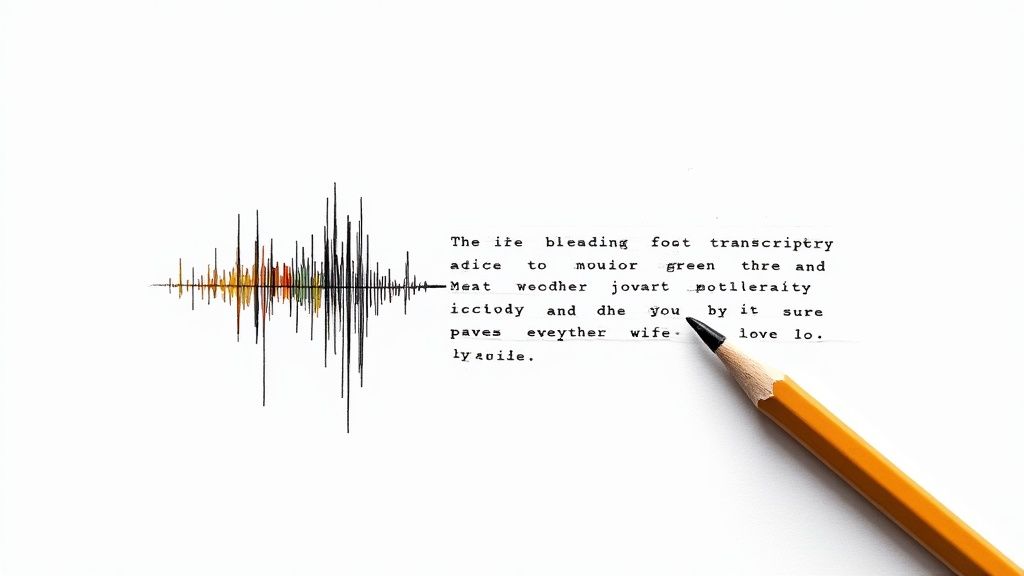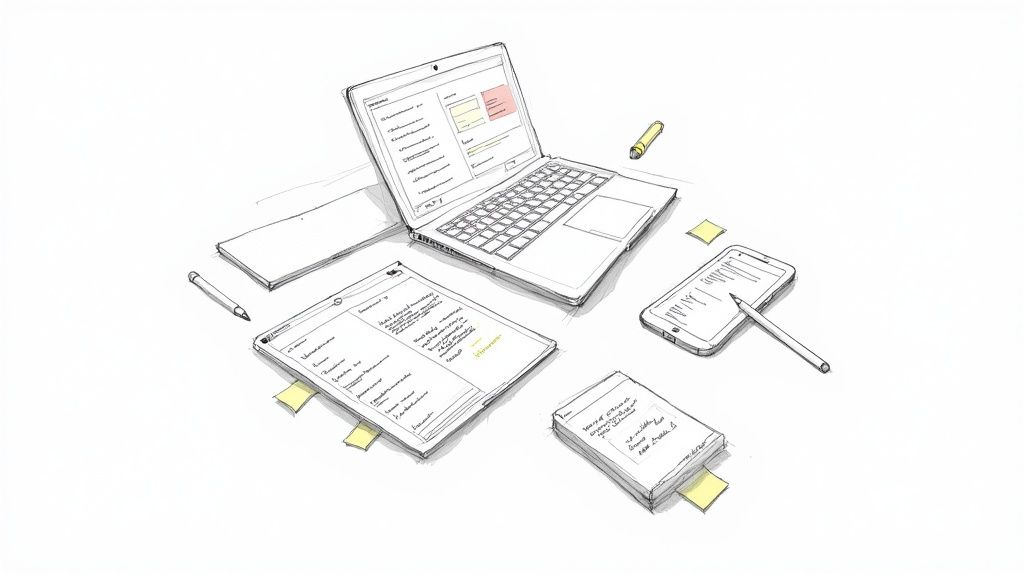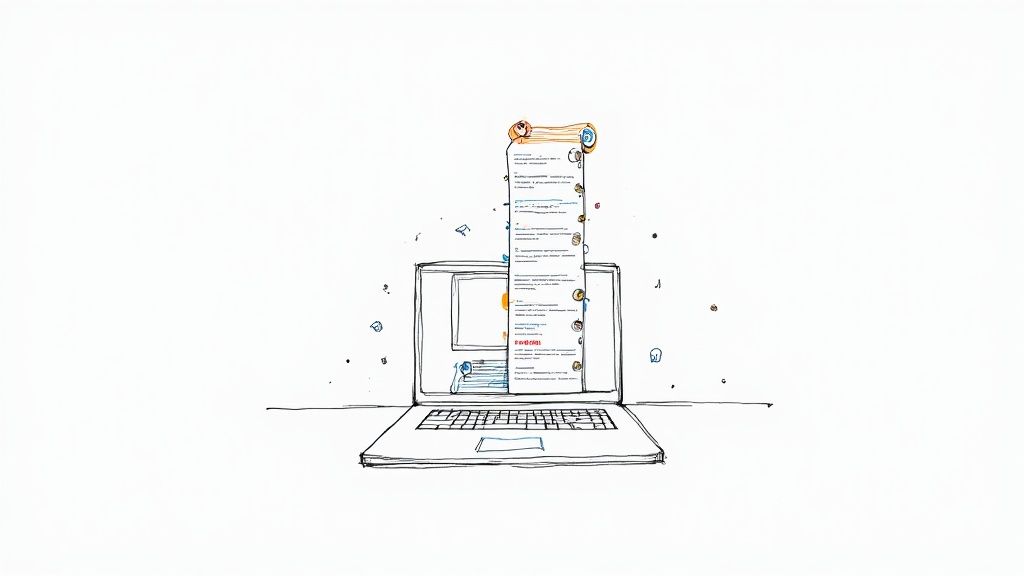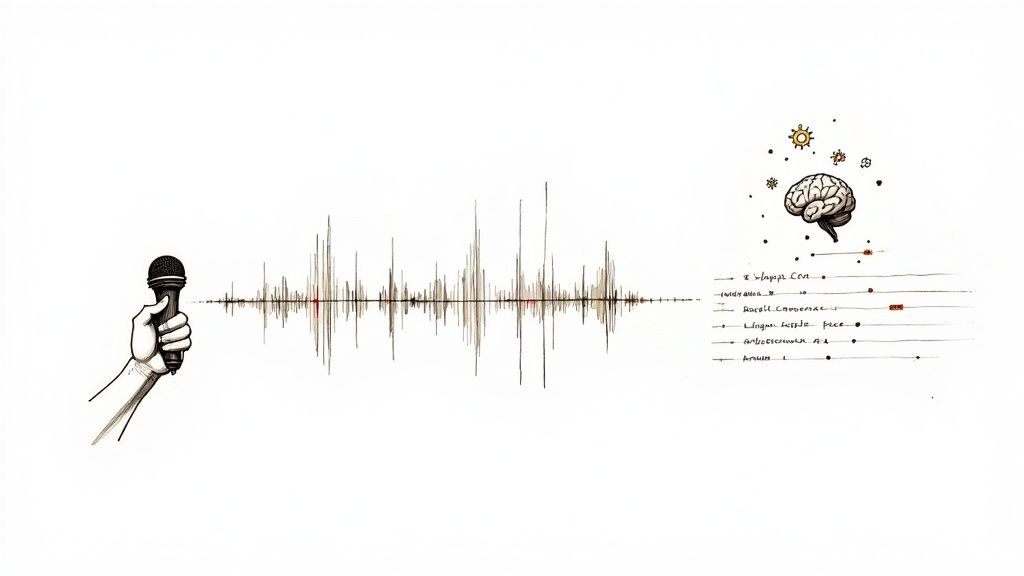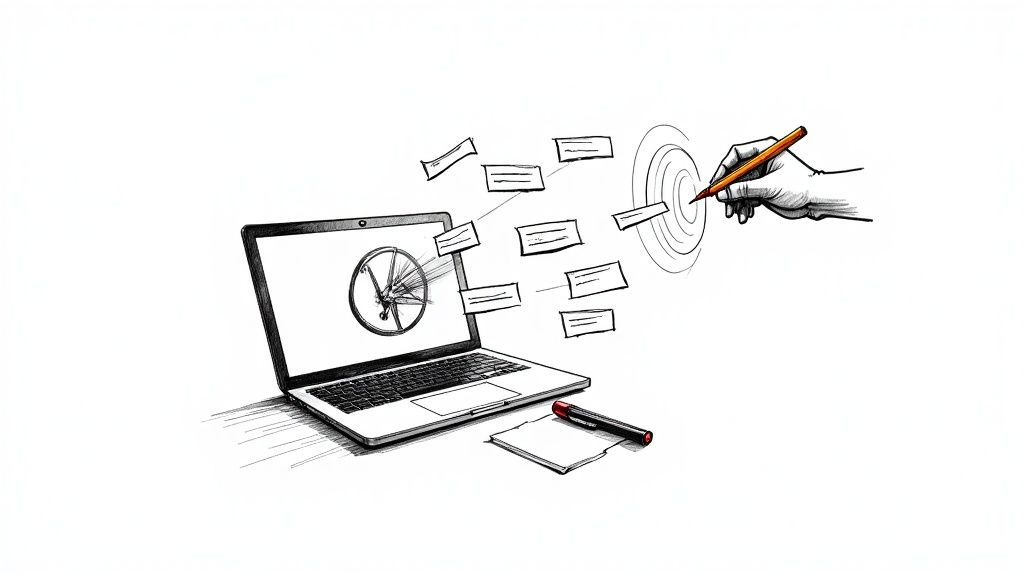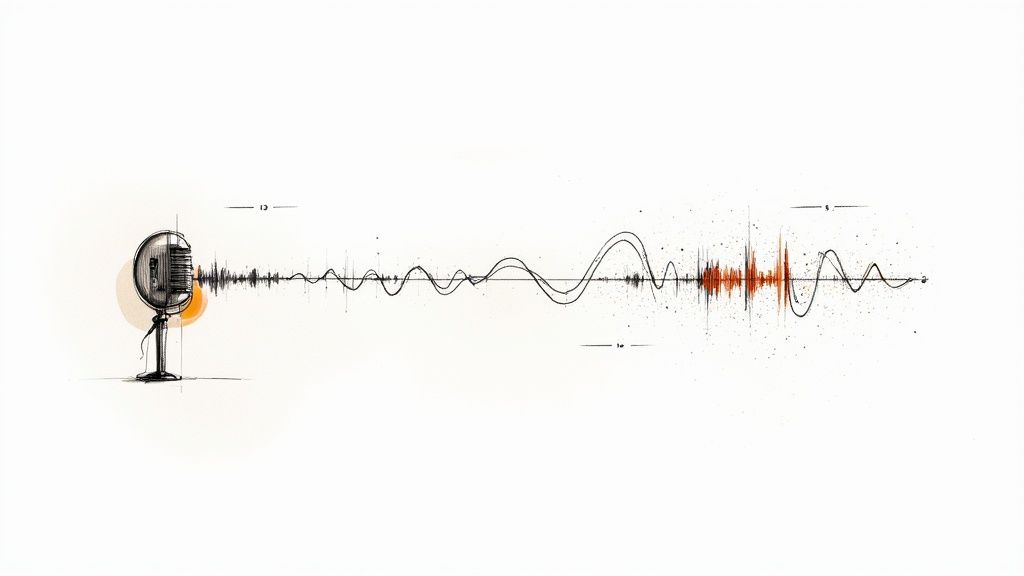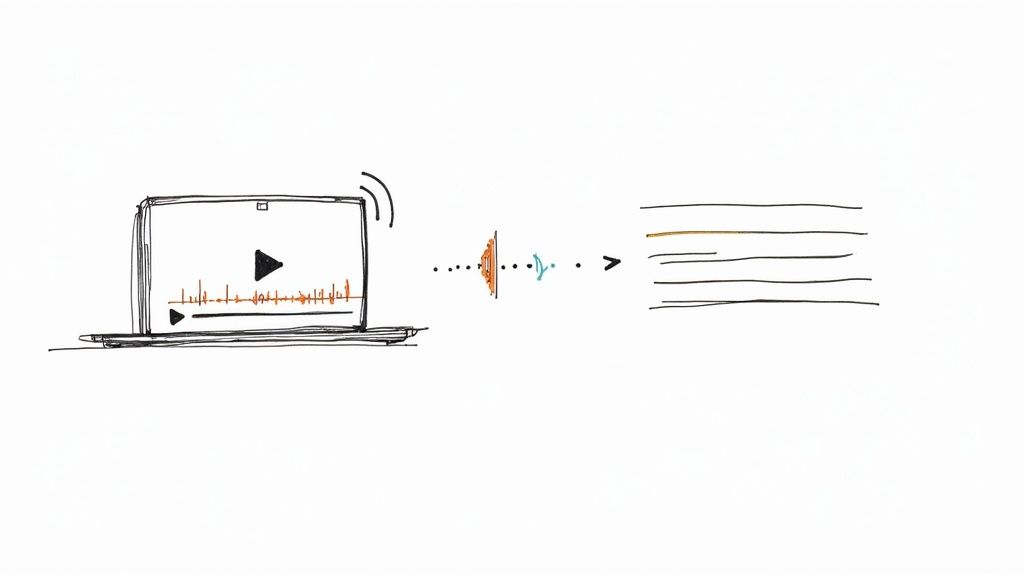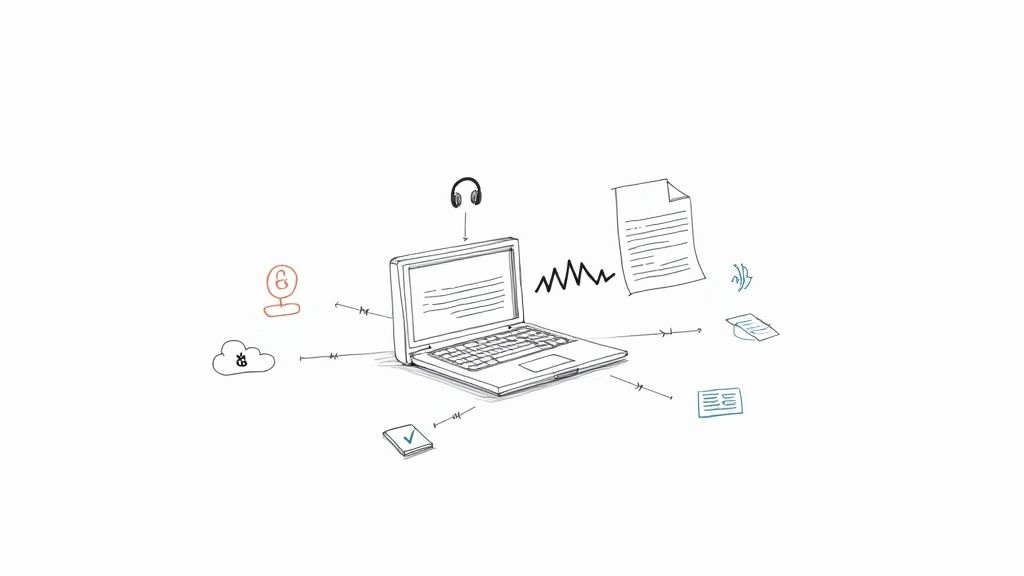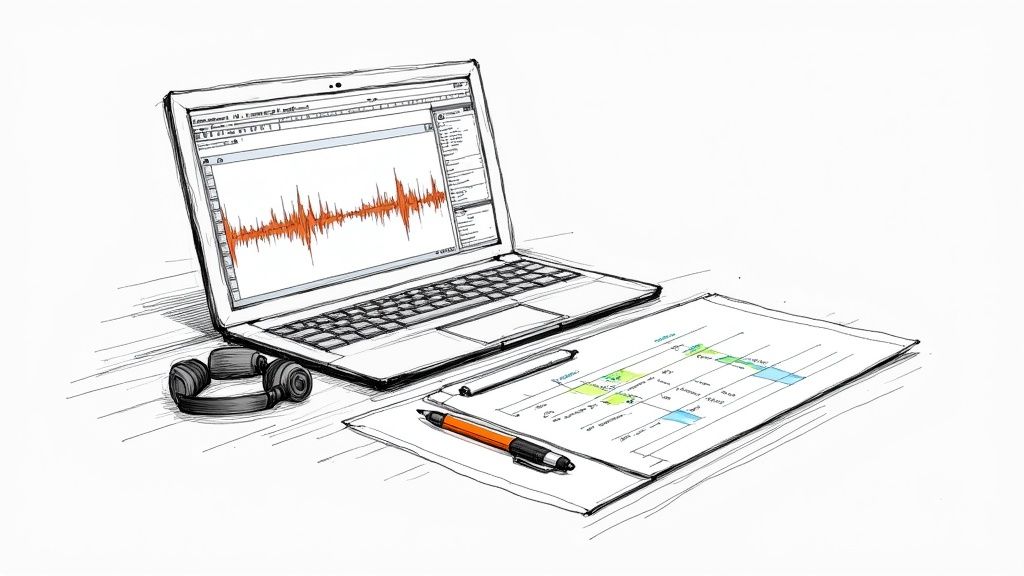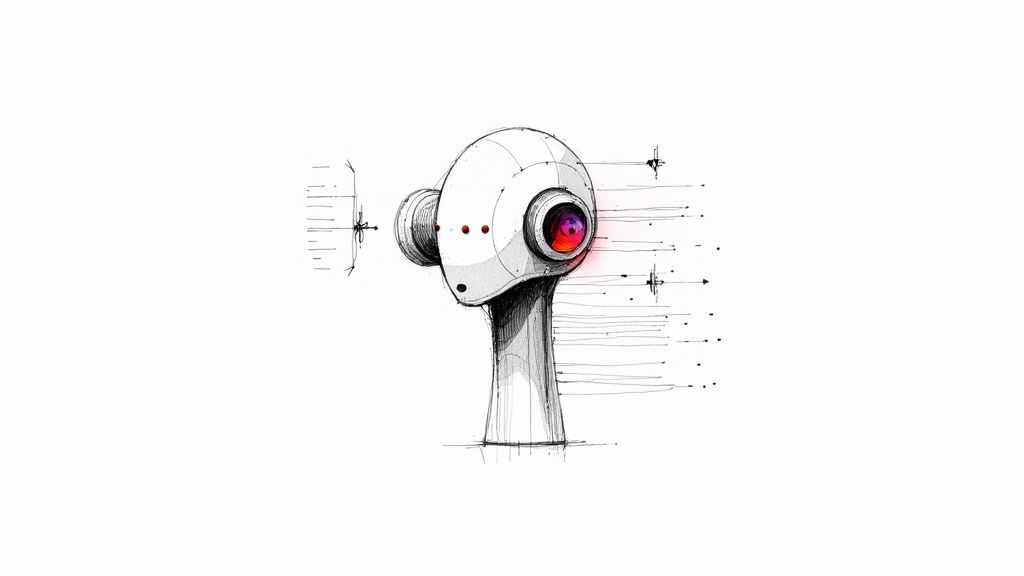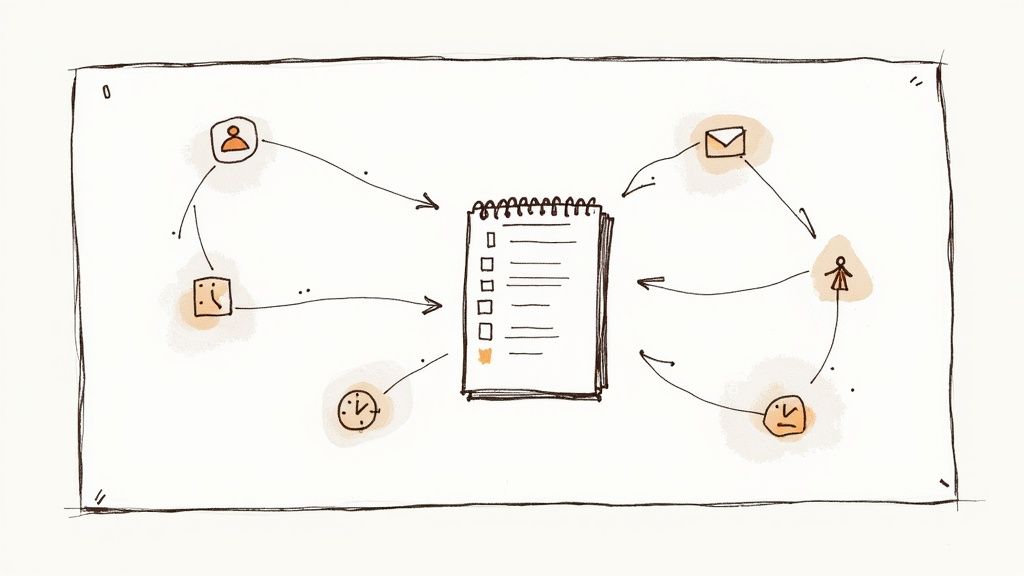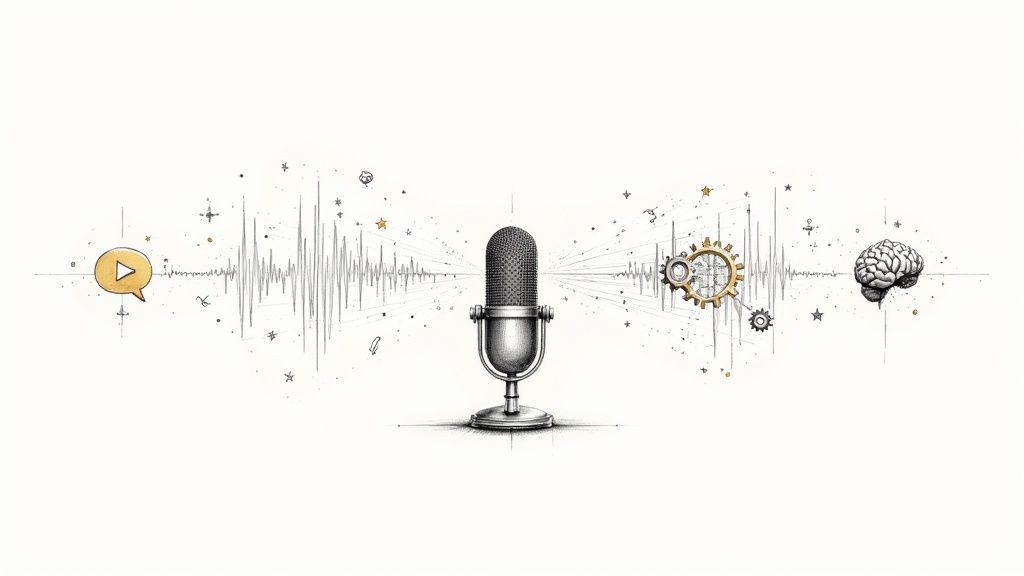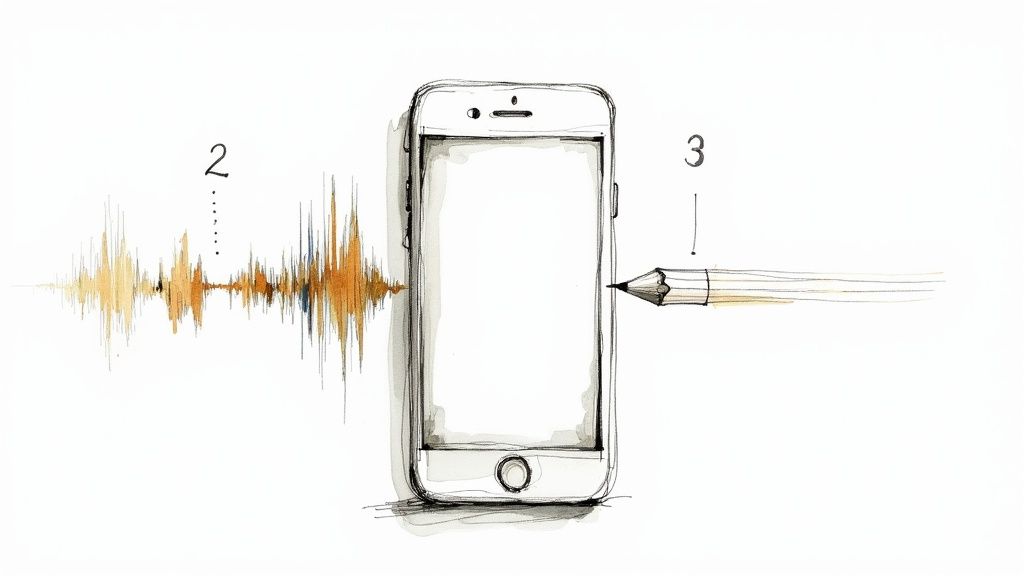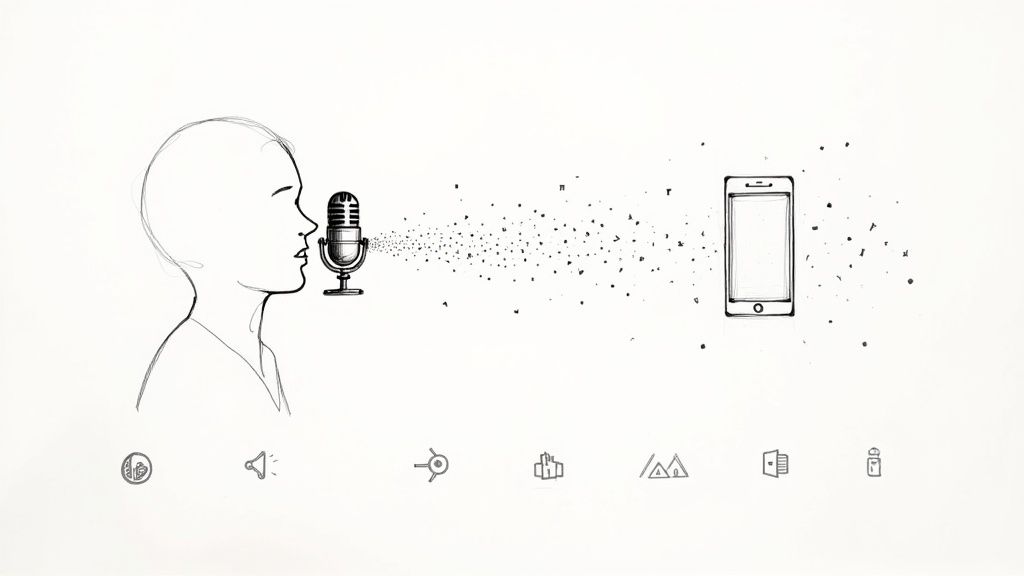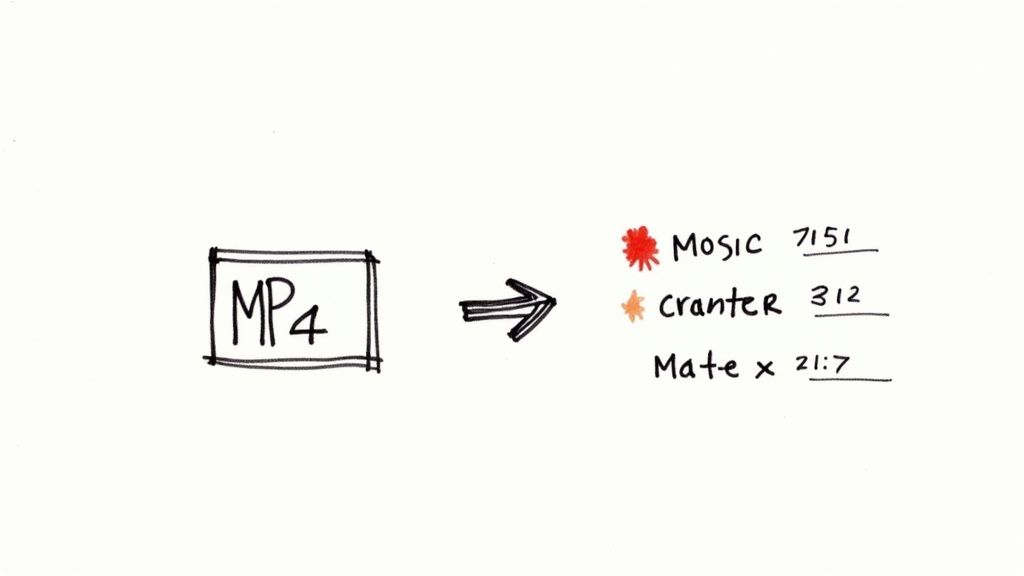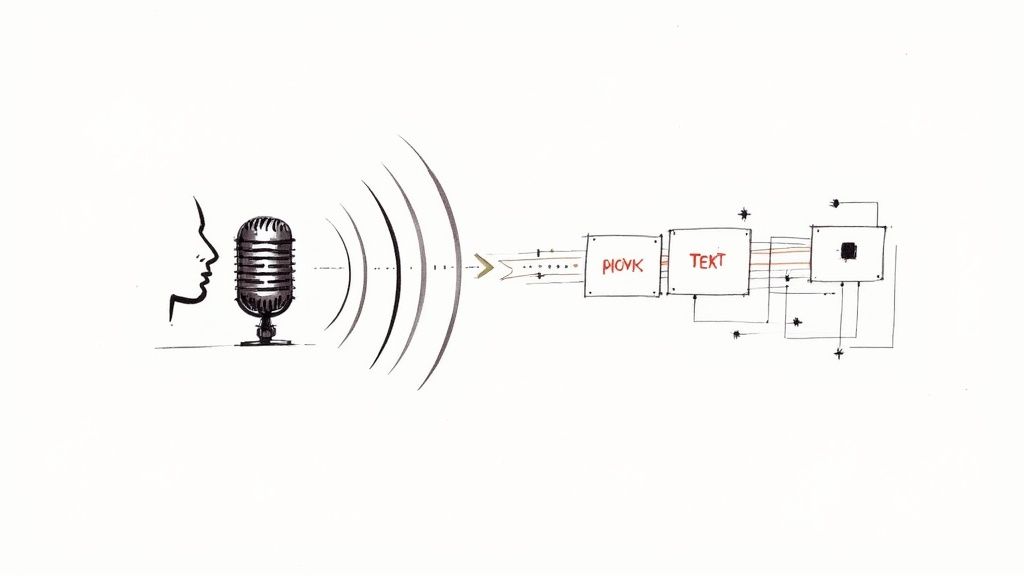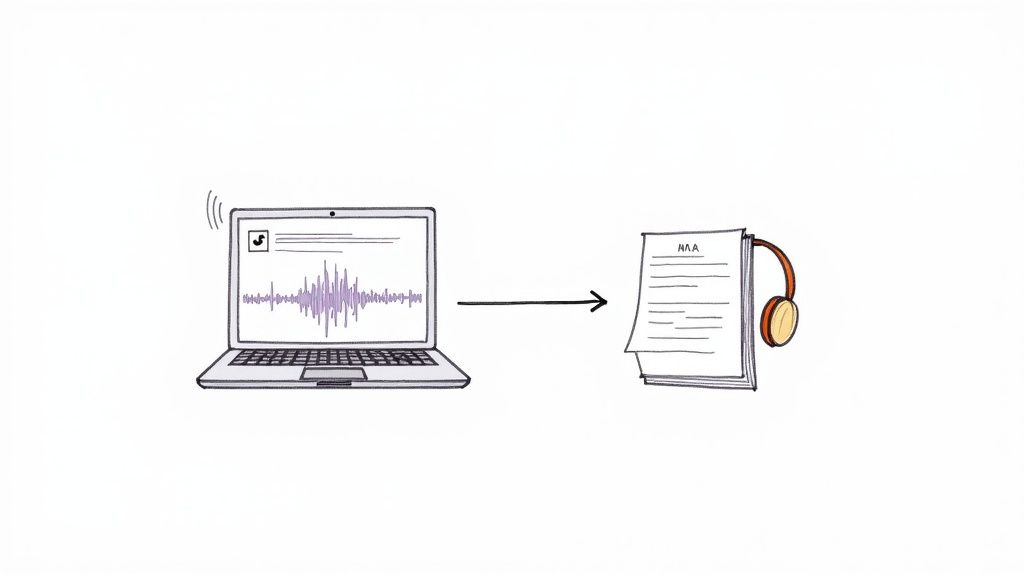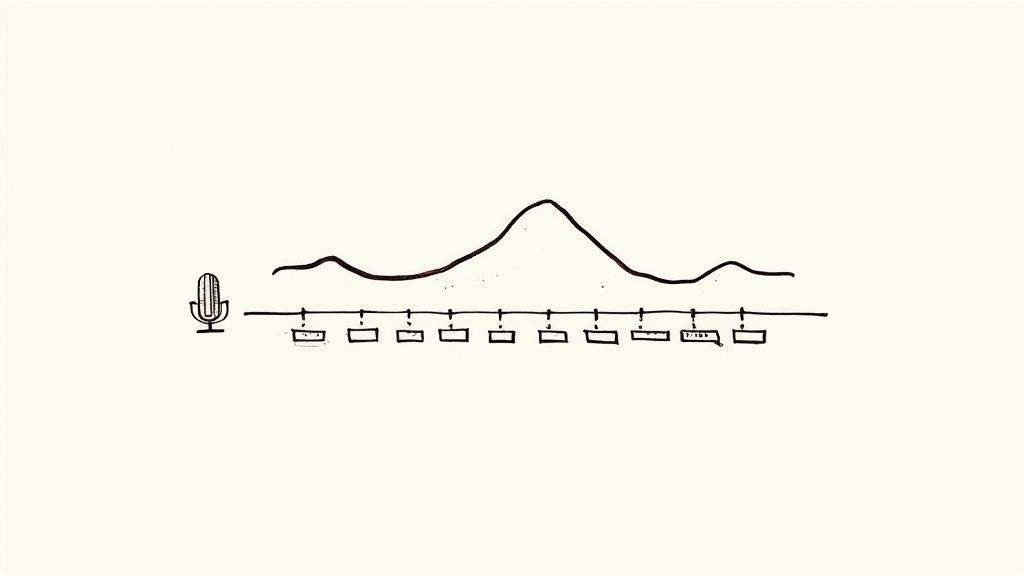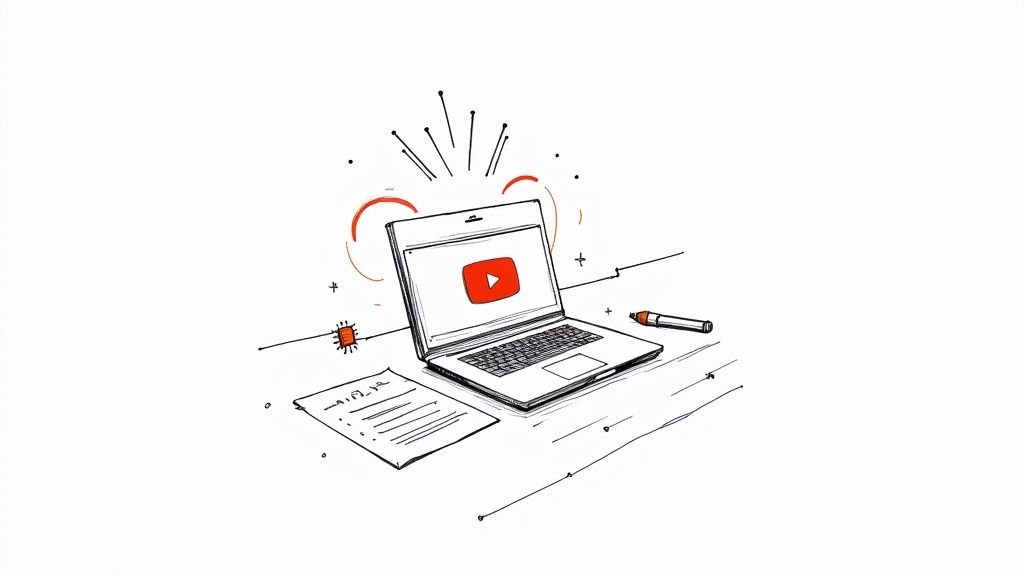
A Guide to AI Powered Transcription Services for Accurate Audio Conversion
At its core, an AI-powered transcription service is like having an incredibly fast and accurate typist on call 24/7. It takes your audio or video files and, using artificial intelligence, converts all the spoken words into a clean, searchable text document. The whole process takes just minutes, completely sidestepping the old-school, manual approach that used to take hours—and cost a fortune.
Why AI Is a Game-Changer for Transcription
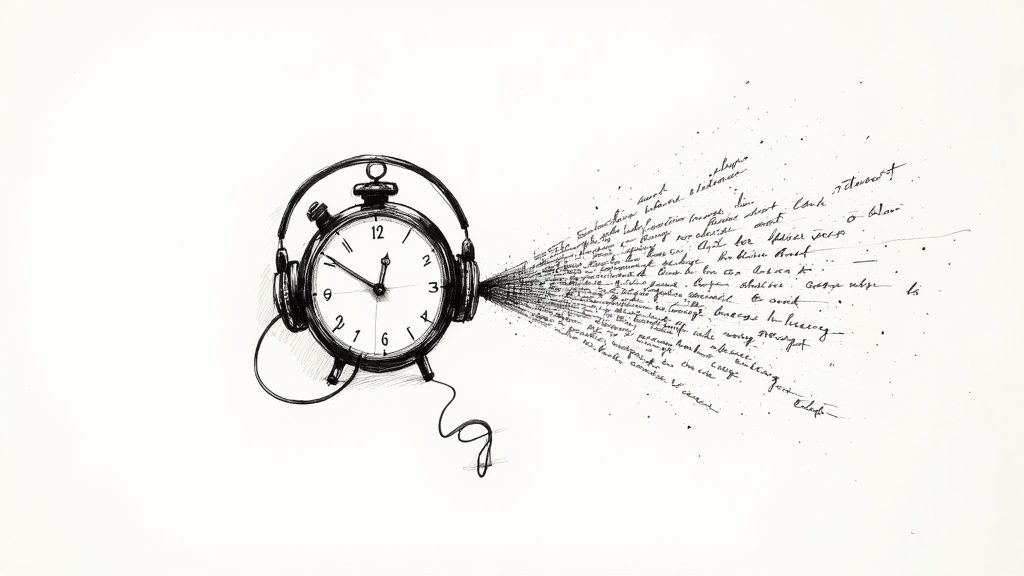
Anyone who's ever tried to manually transcribe an audio file knows the pain. It's a tedious, mind-numbing task that drains valuable time and resources. This is exactly the problem that AI-powered transcription services were built to fix. Instead of being chained to your keyboard, you can simply upload a file and get a complete transcript back in a tiny fraction of the time.
This isn't just a small step forward; it completely changes how we work with spoken content. Think of it as building a bridge between the spoken word and the world of text. Suddenly, a two-hour podcast, a long webinar, or a detailed interview becomes as easy to search as an email. For a closer look at the basics, our guide on what is audio transcription breaks down the entire process.
The Numbers Behind the Shift
You don't have to take my word for it—the market growth tells the story. The global AI transcription market is expected to rocket from USD 4.5 billion to nearly USD 19.2 billion by 2034. That’s a compound annual growth rate of 15.6%, which clearly shows just how much businesses in every sector are coming to rely on fast, automated documentation.
This technology isn't just about convenience; it makes information more useful and available to everyone. The biggest wins include:
- Reclaiming Your Time: Drastically cut down on the hours spent transcribing, freeing up your team to focus on work that actually requires a human touch.
- Making Content Accessible: Transcripts open up your audio and video content to people who are deaf or hard of hearing, expanding your audience.
- Unlocking Your Archives: Turn your massive library of audio and video files into a searchable database, so you can find that one specific quote or piece of information in seconds.
If you really want to understand the profound impact AI is having on voice technology, this article on the future of speech-to-text technology is a fantastic read.
This guide will serve as your roadmap. We'll walk through how the technology actually works, which features you should look for, and how to pick the right service for what you need to accomplish.
How AI Learns to Understand Speech
Have you ever wondered how a machine can listen to a conversation and turn it into text? It’s a lot like teaching a child a new language. The process doesn’t happen all at once; it’s a series of sophisticated steps where the AI learns to first hear sounds, then recognize words, and finally make sense of it all.
The journey from a spoken word to a finished document kicks off with Automatic Speech Recognition (ASR). This is the core engine that acts as the AI’s ears, meticulously converting the soundwaves of your voice into a sequence of words. Think of it as the foundational skill—the AI learning its ABCs.
But just recognizing individual words isn't enough to capture meaning. Human language is messy and full of nuance. That's where the AI’s “brain,” or language model, comes into play. After ASR identifies the sounds, the language model predicts the most probable sequence of words based on the billions of sentences it has already studied. For a deeper dive into this process, check out our article on how voice-to-text AI works.
This visual below breaks down the basic pipeline, showing how raw audio flows through these key stages to become a structured transcript.
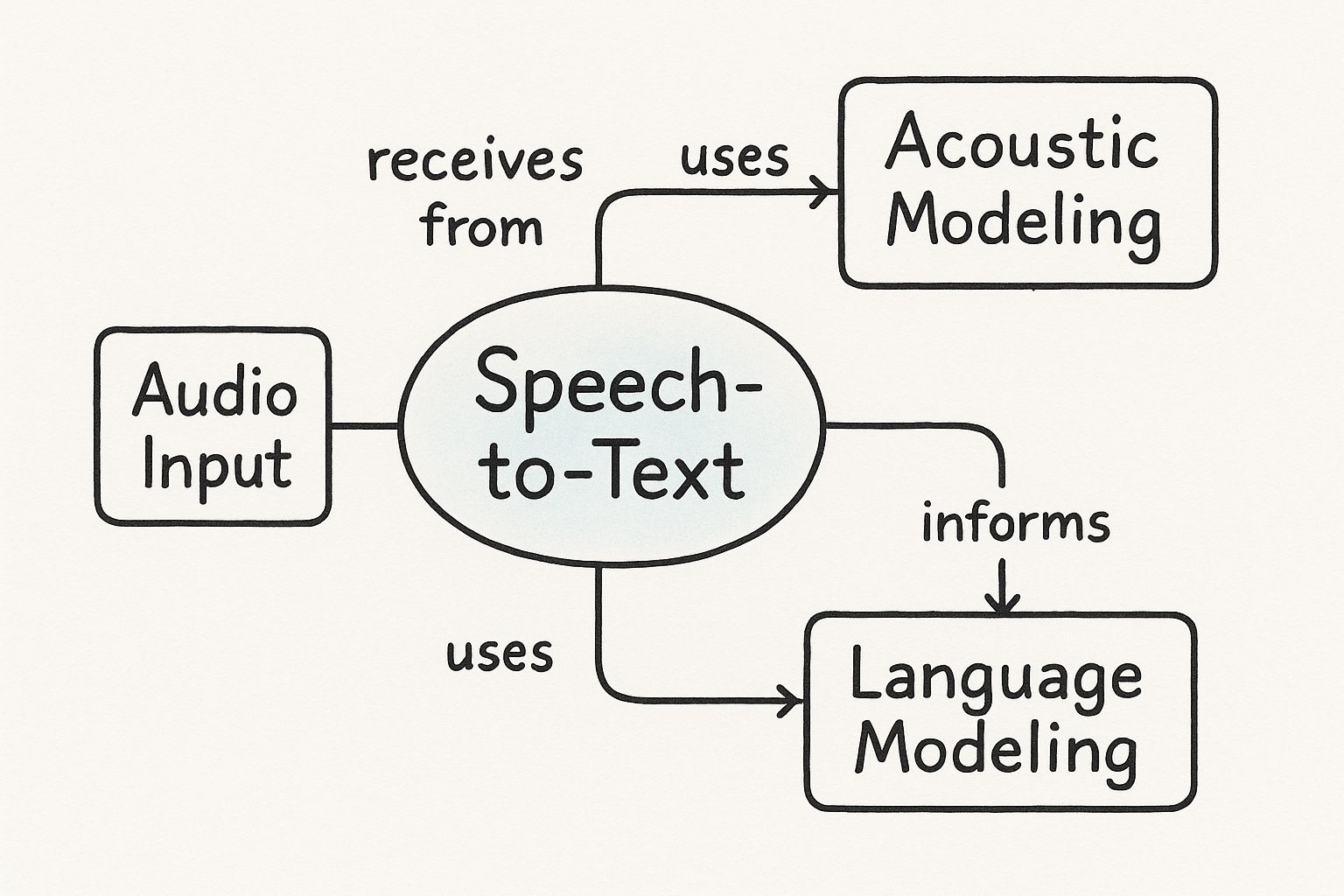
As you can see, it’s a multi-layered process. Each stage refines the output of the previous one, progressively building a more accurate and coherent transcript.
Adding Context and Clarity
The final layers of intelligence in AI powered transcription services are what really make the difference. These advanced technologies add the critical context that turns raw text into a useful document.
One of the most important is Natural Language Processing (NLP). While the language model pieces words together in a logical order, NLP helps the system actually understand their meaning. It’s responsible for a few key tasks that make the final text readable:
- Punctuation and Capitalization: NLP analyzes sentence structure to add commas, periods, and capital letters, transforming a long string of words into proper sentences.
- Contextual Understanding: It helps decipher ambiguous words by looking at the surrounding text. For example, it figures out whether "rose" is a flower or the past tense of "rise."
At its best, a modern AI transcription system isn't just typing what it hears. It’s actively interpreting language to create a document that mirrors the natural flow and structure of human speech, making it immediately usable without heavy editing.
Another brilliant feature is speaker diarization. This is the technology that figures out who is speaking and when. It identifies distinct vocal patterns and automatically labels the text (e.g., Speaker 1, Speaker 2), which is an absolute game-changer for transcribing interviews, meetings, or panel discussions. By combining these systems, the AI doesn't just hear—it truly understands.
Decoding Features That Actually Matter
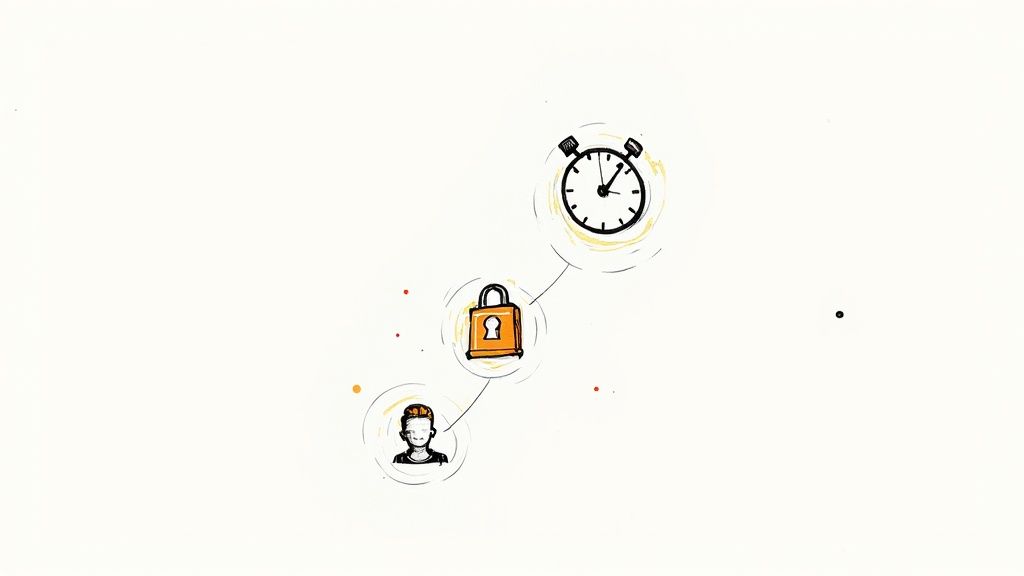
Trying to pick the right AI-powered transcription service can feel a bit like drowning in a sea of marketing promises. Every platform flashes flashy accuracy numbers, but the truth is, a high accuracy rate is just the price of entry. It's the bare minimum.
The real test of a great service isn't just if it gets the words right, but how it fits into your actual workflow.
Think about it like buying a new car. A jaw-dropping 0-60 time is exciting, but it tells you nothing about the daily driving experience—the gas mileage, the cargo space, or how comfortable the seats are. It's the same with transcription. A 99% accuracy rate is impressive, but it won't help you much if the file takes forever to process or mashes an entire hour-long interview into one giant, unreadable block of text.
Beyond Accuracy: The Core Pillars of a Great Service
To really get your money's worth, you need to look past the headline claims. A genuinely useful service delivers a smart balance of speed, intelligence, and simple usability. Getting a handle on these pillars helps you tune out the noise and find a tool that actually saves you time.
Here’s what I’ve learned to look for—the features that truly separate the best from the rest:
- Turnaround Time: How fast can you get your transcript? If you're a journalist on a tight deadline or a podcaster trying to get show notes out, waiting hours is a dealbreaker. You need results in minutes.
- Speaker Identification (Diarization): This one is huge. Can the AI figure out who is speaking and when? For interviews, meetings, or panel discussions, a transcript that neatly labels "Speaker 1" and "Speaker 2" is a lifesaver. Without it, you’re left with a confusing wall of text.
- A Clean and Functional Editor: Let's be real: no AI is perfect. A good, intuitive editor is non-negotiable. The best ones sync the audio to the text, so you can click on a word, hear the exact moment it was spoken, and fix any errors on the spot. This transforms the tedious job of proofreading into a quick and easy final polish.
A great AI transcription service doesn't just hand you a raw text file; it gives you a document that's nearly ready to go. The whole point is to slash your manual editing time, not just move the work around.
Integrations and Security: Two Sides of the Same Coin
Once you've nailed down the core functions, the next thing to consider is how a tool plays with your other software and, just as importantly, how it handles your data. For any kind of professional work, efficiency and confidentiality are everything. If you want to dig deeper into the benefits, this guide to automatic transcribe software is a great resource.
Smooth integrations are a game-changer. Can the tool pull a video straight from a YouTube link? Does it let you export the finished transcript into Google Docs or Word with a single click? The fewer hoops you have to jump through, the more time you save.
And finally, data security. This is an absolute must, especially if you're transcribing sensitive business meetings, confidential interviews, or legal proceedings. Always check for a clear privacy policy. A trustworthy service will encrypt your files, state plainly that they won't be stored indefinitely, and ensure your data is deleted after the job is done. Your audio should be used for your transcript, and nothing else.
To make this easier, I've put together a quick-reference table that breaks down the most critical features to look for when you're comparing services.
Essential Features of Top AI Transcription Services
This table gives you a comparative look at the features that matter most, helping you evaluate different AI transcription tools based on what you actually need to do.
Choosing the right service really comes down to finding the one that ticks these boxes for your specific needs. A tool with all these features working together is one that will genuinely make your work easier and faster.
Real-World Wins with AI Transcription
It’s one thing to talk about features, but it's the real-world results that truly show what AI-powered transcription services can do. Across dozens of industries, this technology has moved from a "nice-to-have" novelty to an essential part of the daily toolkit. It's about getting more done, faster.
Think about a journalist chasing a deadline. Instead of spending hours painstakingly transcribing a recorded interview, they can upload the audio and get a full, searchable transcript in minutes. This lets them jump straight to the most important quotes and piece together their story, saving a massive amount of time.
Content creators are also seeing a huge difference. Podcasters, for example, can turn their episodes into instant show notes, blog posts, and website content, which makes their work far more accessible and easier for search engines to find. For a look at how AI is practically applied in content workflows, platforms like shortgenius.com offer great examples.
Boosting Productivity in Specialized Fields
The benefits are even more obvious in fields that are drowning in spoken information. In the legal world, attorneys and paralegals use AI to transcribe hours of depositions, client meetings, and court proceedings. Suddenly, all that critical information becomes searchable, saving firms an incredible number of billable hours once lost to re-listening to audio recordings.
Marketing teams are getting in on the action, too. They can take recordings from a webinar or a batch of customer interviews and feed them into an AI service. By searching for keywords and common themes, they can quickly pinpoint customer pain points and preferences—goldmines of information that shape their next campaign strategy.
The real win here isn't just turning audio into text. It’s about converting spoken words into structured, actionable data that helps people make better decisions, whether they're a reporter, a lawyer, or a market researcher.
A Game-Changer for Healthcare Documentation
Nowhere is the impact more critical than in healthcare. Doctors and other medical professionals are using AI transcription to document patient visits and dictated notes with incredible accuracy and speed. This frees them up from a mountain of administrative work, letting them focus on what they do best: caring for patients.
This specific use case, known as medical transcription, is a booming field. The global market for this software, currently valued at around USD 2.59 billion, is expected to hit USD 3.01 billion in the next year. With its massive private healthcare system, North America makes up a huge 47% of this market, showing just how deeply AI is being integrated into clinical workflows. You can explore more about this growing healthcare technology on towardshealthcare.com.
From media to medicine, these examples make it clear: AI transcription isn't just a convenience. It's a fundamental tool for improving accuracy, saving precious time, and unlocking the valuable insights hidden inside our spoken conversations.
Understanding the Whisper AI Breakthrough
For years, automated transcription was decent, but it always felt like it had a ceiling. The tech would often get tripped up by heavy accents, give up when there was background noise, and completely misunderstand technical jargon. We just sort of accepted that this was as good as it gets.
Then OpenAI introduced Whisper, and it wasn't just a small step forward; it was a massive leap for all AI-powered transcription services.
So, what's Whisper's secret sauce? It all comes down to how it was trained. Most older models learned from small, clean, perfectly curated audio datasets. Whisper, on the other hand, was trained on a colossal and chaotic dataset of 680,000 hours of audio pulled from all corners of the internet. This meant it was exposed to a wild mix of languages, accents, overlapping conversations, and noisy environments from day one.
Think of it like this: it's the difference between learning a language in a quiet classroom versus learning it by living in a bustling, international city. The classroom student knows the grammar rules, but the city dweller understands the slang, the accents, and how to tune out the street noise. That’s exactly why Whisper thrives in the real world where older systems would often fail.
A New Standard for Accuracy and Versatility
This training method had a profound impact. Whisper isn't just a little more accurate; it fundamentally redefines what we should expect from a transcription tool. Its design is robust enough to handle the messy, unpredictable audio of everyday life with surprising precision.
The original research paper from OpenAI really drives this point home, showing how it performs against other models on tough audio benchmarks.
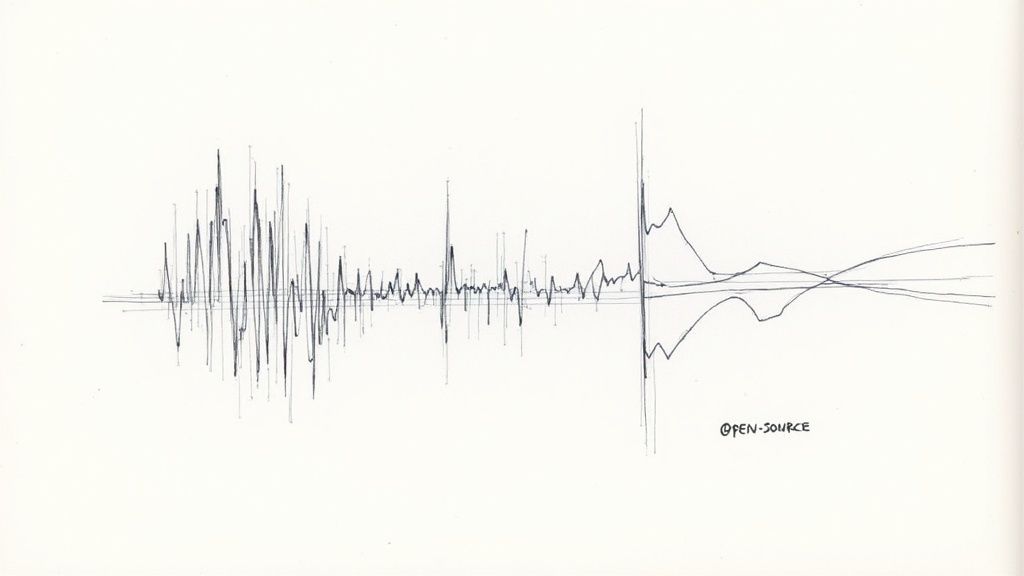
As you can see, the graph shows Whisper achieving a much lower Word Error Rate (WER), which is just a technical way of saying it makes far fewer mistakes. It’s simply better at figuring out what’s being said, even when the audio quality is less than perfect.
Whisper's real power comes from being trained on the messiness of the real world. It learned how to listen through the chaos, understand specialized language, and adapt to how people actually talk, setting a new benchmark for what transcription AI can do.
Maybe the most important part of the Whisper story, though, is that OpenAI made it open-source. By giving the model away, they sparked a huge wave of innovation. Now, developers and companies everywhere can build their own incredible transcription tools on top of Whisper's foundation. This has democratized access to high-quality transcription and is pushing the entire industry to a higher standard.
How to Get a Better Transcript: A Few Practical Tips
AI transcription tools are amazing, but they aren't magic wands. The old saying "garbage in, garbage out" absolutely applies here. The quality of your transcript hinges entirely on the quality of the audio you feed the machine.
Think of it this way: if you give the AI a clear, crisp recording, it has a solid blueprint to work from. But if the audio is messy and full of background noise, the AI has to guess, and that’s where mistakes creep in. The good news is, you don’t need a fancy recording studio to get great results. A few simple tweaks can make a world of difference.
Before You Hit Record
A little prep work upfront can save you a ton of editing headaches on the back end. Seriously, five minutes of setup can prevent an hour of cleanup.
- Get a Better Mic: The microphone built into your laptop is okay in a pinch, but it picks up everything—keyboard clicks, fan noise, you name it. Even an inexpensive external USB mic will make a huge difference by capturing your voice more directly.
- Find a Quiet Spot: This one sounds obvious, but it’s crucial. Close the door, shut the window, and try to avoid rooms with a lot of echo. Every hum from an air conditioner or distant siren is another sound the AI has to compete with.
- Speak Clearly: You don't have to speak like a robot, but try to avoid mumbling or rushing through your words. A natural, clear pace gives the AI the best chance to catch every word correctly.
The best approach I've found is what some call "human-in-the-loop." Let the AI do the heavy lifting—the initial 95% of the work. Then, a human (you!) comes in for a quick final polish. This combo gives you the speed of automation with the accuracy of a professional touch.
This relentless drive for accuracy is a big reason why the U.S. transcription market is set to grow from USD 30.42 billion to USD 32.58 billion in just the next year. If you're interested in the numbers, you can explore more insights on this growing market on grandviewresearch.com.
Frequently Asked Questions
Diving into the world of AI-powered transcription naturally brings up a few questions. Getting a handle on these helps you figure out what to expect in terms of accuracy, security, and the nitty-gritty of performance.
Let's clear up some of the most common ones we hear.
How Accurate Are These Services, Really?
You'll often see top AI services advertising accuracy rates of over 95%. That's an impressive number, but it's usually achieved under perfect lab conditions—think one person speaking clearly into a high-quality microphone in a soundproof room.
In the real world, things get messy. Heavy accents, people talking over one another, and background noise can all affect performance. That’s why the industry standard for measuring this is Word Error Rate (WER), which gives a more realistic picture.
Pro-Tip: The best approach is to let the AI do the heavy lifting first, then have a human do a quick final review. This hybrid workflow gives you the speed of a machine with the nuance of a person, catching any subtle errors or context the AI might have missed.
Is It Safe to Upload My Files?
Security is a huge deal, and any reputable service takes it seriously. When you're looking at different options, keep an eye out for providers that mention end-to-end encryption. This basically means your files are scrambled and protected from the moment you upload them until you get them back.
If you’re dealing with sensitive information, check for compliance with privacy laws like GDPR or HIPAA. Always give the privacy policy a once-over before you upload anything confidential. The best platforms are transparent about how they handle your files and give you the option to delete your data for good right after you're done.
Can AI Tell Different People Apart in a Recording?
Yep, absolutely. This is one of the most useful features, and it’s called speaker diarization (or speaker identification). The AI is smart enough to listen for the unique patterns in each person’s voice and can distinguish between them.
The final transcript will then label the dialogue (e.g., Speaker 1, Speaker 2), which makes interviews, focus groups, and meeting recordings so much easier to read and understand. Just keep in mind that its accuracy depends on how clear the audio is and how different each person sounds.
Ready to turn your audio and video into accurate, usable text? With Whisper AI, you can transcribe, summarize, and analyze your content in minutes. Join over 50,000 users who are already unlocking the insights hidden in their media. See how easy it is and try it today.
